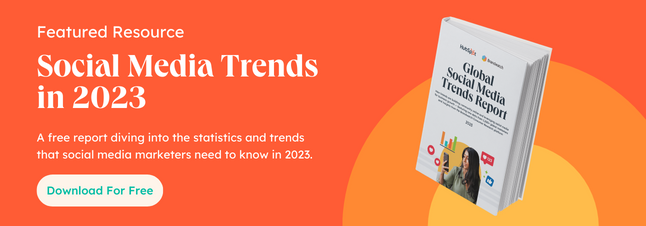Facebook is the most popular social network in the world. Its users are on the platform to connect with friends, watch videos, and share snippets of their own lives.
The channel is also a great platform for businesses, as many consumers report using it to interact with the brands they enjoy. In fact, in a HubSpot poll, 51% of respondents reported primarily using Facebook for product research.
Given this, it’s essential to understand how to use the platform to meet your business needs. This post will explain why businesses should post on Facebook and share an expansive list of Facebook post ideas that you can use to interact with your audience and generate engagement.
Keep reading, or jump to the section you’re looking for:
- Why should businesses post on Facebook?
- How often should you post on Facebook?
- What makes a business Facebook post great?
- 41 Facebook Post Ideas For Your Business
Why should businesses post on Facebook?
The decision to post on Facebook should depend on your business’s individual marketing goals, but we’ll outline some benefits below. Firstly, in Q4 of 2022, Facebook reported almost 2 billion daily active users on the platform, which means that segments of your audience are likely already using the network.
When your audience discovers you’re on the platform, you can work to develop a community of like-minded consumers and deepen the connection they have to your brand. When you engage with them, you’ll learn more about their likes and interests, making it easier for you to create content they’ll enjoy and interact with.
Also, maintaining a Facebook profile is a great way to show your audience that you’re active and in business. As most users use the platform to research products, stumbling upon an inactive Facebook profile may prompt them to bring their business elsewhere.
Lastly, 200 million + businesses are already using the platform to meet their business goals, so you should join them.
How often should you post on Facebook?
A recent HubSpot experiment found that, overall, businesses should aim to post on Facebook two to five times per week.
While this is simply an average, it’s okay to adapt your strategy depending on your audience insights and what seems to bring the most success on the platform. But the experiment did note that posting more than five times per week can substantially decrease ROI.
All in all, spend time on the platform, learn from your audience, and use your page metrics to find out the best combination for your business.
What makes a business Facebook post great?
Gives your audience something they need.
If you know who your audience is, the next step is figuring out what they need, and how to give it to them.
One way to figure this out is to look at your Facebook analytics. Track posts with the most and least engagement to see what type of posts resonate with your audience. Next, step back and look at your content from your customers’ perspective. This will help you ask useful questions and post the right Facebook post ideas at the right time.
Shares a clear message.
Every idea comes from somewhere. And if you’re the one coming up with the idea, you know where it came from. That gives you more information than your audience, and it makes it easy to think you’re posting a clear message, even when you’re not.
To make sure your message is simple and direct, try these tips:
- Create a quick outline of what you want to include in your post.
- After writing, step away for a couple of hours before you edit your message.
- Define or link to definitions of industry-specific terms.
- Use writing tools to edit and proofread your posts.
- Read your post out loud to yourself to make sure it’s easy to understand.
Has a personality and point of view.
B2B or B2C, professional or casual, people are still people. When your audience is scanning Facebook, they’re humans looking to connect or solve a problem. So, to grab your audience, it’s important to show them who you are.
But who are you? Are you being yourself on Facebook and is your personality what helps to sell your brand? Or are you a writer who’s writing on behalf of a business? First, understand who your audience wants to hear from. Next, look to your brand to develop a voice that’s consistent and authentic.
Once you have a writing voice that sings with brand personality, figure out how to use that voice. Think about the best way to add to a thread about breaking business news or how to announce an upcoming event. Decide which emojis add or detract from your text.
Whether you’re commenting, posting, or adding a tag, show your unique voice with every interaction.
Storytelling.
Stories are powerful tools. With just a few sentences, you can draw an audience in, inspire them, and drive them to take action.
And Facebook is an excellent platform for storytelling. You can use images and videos to tell your story, add captions to support your narrative, or connect a story to specific customers or followers.
Whether you want to share a challenging moment or a funny anecdote, storytelling can spark emotion and engagement.
If you’re not sure how to structure your story, this framework can help you get started.
Offers new or useful information.
If your Facebook page is all promotions all the time your audience may get in the habit of only checking your page when they want your product.
Instead, Facebook posts should be full of helpful insights that inspire your audience. The more time users spend scanning your Facebook posts, the more likely they are to become loyal customers.
To start, keep up with the latest news in your niche and industry and find easy ways to keep your followers up to date. Work with thought leaders for one-of-a-kind insights. Connect with followers to make user-generated content.
Then, find ways to connect the problems you’re hearing in comments and direct messages to the products and services you offer. This way, the useful information you’re offering helps your customers solve those problems while supporting your business goals.
Gives users some variety.
While some businesses choose two or three Facebook post ideas and stick with them, it’s best to try a little bit of everything to keep your Facebook page fresh and interesting. If some post types are too time-consuming to schedule consistently, try to create these posts in batches and space them out over time to surprise and delight your followers.
HubSpot customers: You can schedule and track your Facebook posts with HubSpot’s social media management software.
Grabs attention visually.
Over 35% of Facebook posts include images and 15% feature videos. This means that more than half of what’s posted on Facebook is visual.
So, don’t just think about visual media as an extra for your post. Make images the star, and use images that enhance your brand voice.
If you’re not a photographer or illustrator, that might sound like a big challenge. But there are a few tips that can help anyone pull powerful images into every Facebook post.
- If you use stock photos, find a way to edit each image to make it look one of a kind.
- Look into AI image choices.
- Pay attention to the details, like Facebook image best practices.
- Try taking original photographs — even images from your phone can look great.
If you’re new to photography, these product photo tips can also help.
Below we’ll list various Facebook post ideas for businesses that you can use to generate engagement, drive traffic, and boost conversions.
Facebook Post Ideas For Your Business
1. Promote your website.
Business types this post idea is best for: Local Business or Place, Company Organization or Institution
Why it works: A great first post to make on Facebook is promoting your website. When you share a link on Facebook, customers get a full-sized preview of what the link leads to. If you’ve designed an eye-catching website, you may entice your users to follow the link and visit your website, which in turn drives traffic and helps you convert leads.
2. Tell a story.
Business types this post idea is best for: Company Organization or Institution, Brand or Product

Why it works: A smart way to engage with your audience on Facebook is to tell a story.
This story can be about your brand, like an experience that sparked your interest, or your brand’s mission and how you became what you are today.
You’ll share a bit of backstory with your audience, give them something to relate to, and get them interested in what you have to offer.
3. Share behind-the-scenes content.
Business types this post idea is best for: Brand or Product, Local Business or Place, Cause or Community

Why it works: Customers enjoy doing business with you, but it’s also exciting for them to see how you do business. Sharing behind-the-scenes content on Facebook allows them to understand the day-to-day operations that generate the products or services they enjoy.
For example, if you’re a clothing company, you could share a video that shows how you make your products. Or a local shop could share progress on construction, like in the image above.
4. Ask your followers questions.
Business types this post idea is best for: Company Organization or Institution, Brand or Product

Why it works: A great way to generate engagement with your Facebook audience is to ask them questions. If people reply, you’ll gain valuable insight into how they think and feel, and you’ll also have the opportunity to respond to comments and let them know you’re listening. Above is an example of a question-type Facebook post from the Strand bookstore.
5. Post tutorials and how-tos.
Business types this post idea is best for: Brand or Product, Artist, Band or Public Figure
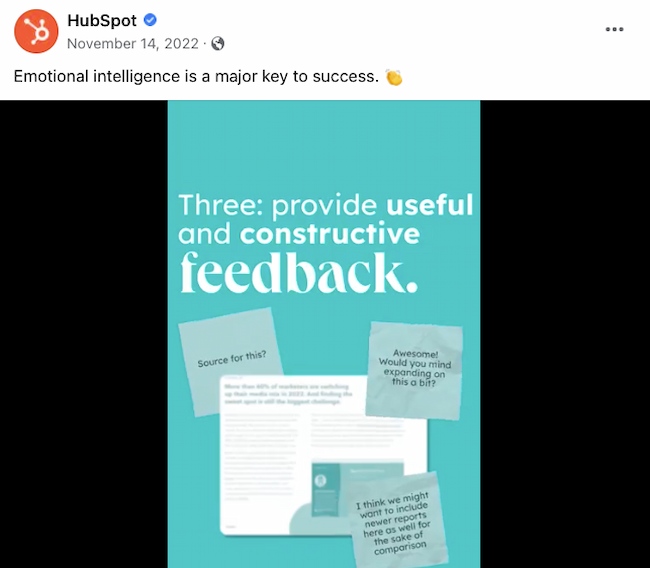
Why it works: Sharing how-tos and tutorials on your Facebook page is a great way to generate engagement with your audience, especially if the content is relevant to your business offerings. They’ll recognize and appreciate that you’re willing to help them succeed with your product, and they’ll continue to return to your page to seek out similar information in the future.
This type of post allows for creativity, as it doesn’t necessarily need to be text-based. You can create an informational video tutorial, infographic, or whatever best meets your needs. Above is an example of a how-to video tutorial post on Facebook.
6. Share industry-related news and content.
Business types this post idea is best for: Company Organization or Institution

Why it works: Your Facebook audience is following you on the platform because they care about what you have to say. Given this, it’s safe to assume that they also care about news relevant to your industry, so consider posting this type of content on your Facebook page.
The example above is from Goodwin Recruiting, sharing insights from Harvard Business Review about career transitions.
7. Share user-generated content.
Business types this post idea is best for: Local Business or Place, Company Organization or Institution, Brand or Product

Why it works: A great way to generate trust with your audience on Facebook is to share user-generated content (UGC). UGC is content created by people who have used your products and services or have had some experience with your business.
UGC is also a valuable form of social proof, which essentially means that your audience will trust your legitimacy because other consumers like what you have to offer. In fact, according to 2022 Statista research, 84% of consumers are more likely to trust a brand that incorporates UGC in its marketing.
This content can be anything from product reviews and testimonials to photos that customers have shared using your products. The example above is from Uoma Beauty where they’ve shared a picture of a fan using their product.
8. Post videos.
Business types this post idea is best for: Brand or Product, Artist, Band or Public Figure, Entertainment

Why it works: Consumers love videos, so sharing them on Facebook is a great way to generate engagement and excitement for your brand, especially if they’re high quality.
The video post above is an example from Bricks & Wood, an apparel brand, of a video they’ve posted on the platform featuring their most recent seasonal campaign.
9. Post blog content.
Business types this post idea is best for: Company Organization or Institution, Brand or Product

Why it works: Cross-posting content from your blog is a great way to drive traffic to your website and expose your blog content to an audience that may be unfamiliar with it. In the example above, SaaS product Userpilot shares content from their blog to Facebook.
10. Use hashtags.
Business types this post idea is best for: All business types
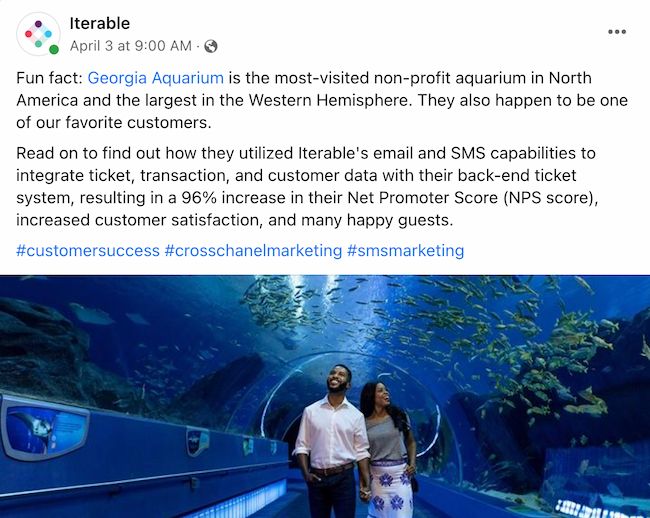
Why it works: Facebook uses hashtags to organize conversations about specific topics all in one stream. Use industry-related hashtags in your posts to join in on conversations that are already happening on Facebook. You can also use brand-specific hashtags to increase visibility and engage with audiences.
11. Post about trending topics.
Business types this post idea is best for: Company Organization or Institution, Brand or Product, Cause or Community

Why it works: Like using hashtags, posting about trending topics gives you an in on the conversations people are already having. People are also more likely to talk about a current trend in the moment, which can drive engagement to your page.
To make the most of this tip, stay on top of relevant industry trends and general internet trends. Then, post about topics you think your audience wants to hear about.
12. Share branded graphics.
Business types this post idea is best for: rand or Product, Artist, Band or Public Figure
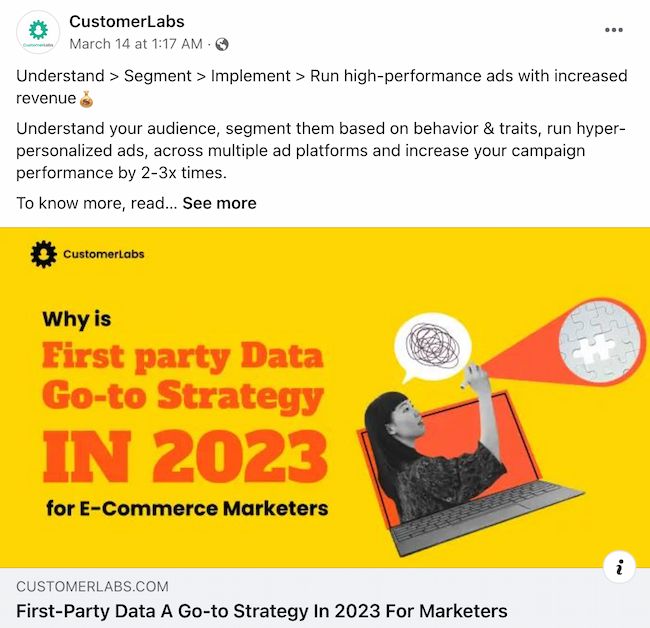
Why it works: One of the main goals of marketing is to increase awareness and recognition of your brand.
Given this, Facebook is a great platform to share branded graphics. This strategy shows your audience who you are and gives them the cues they need to recognize your brand and pick you out of the crowd.
13. Share product photos.
Business types this post idea is best for: All business types
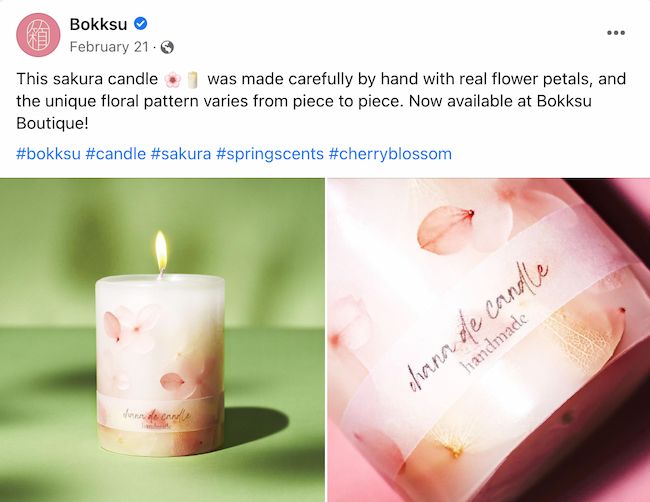
Why it works: The average engagement rate on Facebook is .07%. The average engagement rate for image posts on Facebook is 0.12%, so take advantage of this and post images on the platform.
14. Post infographics.
Business types this post idea is best for: Company Organization or Institution, Brand or Product
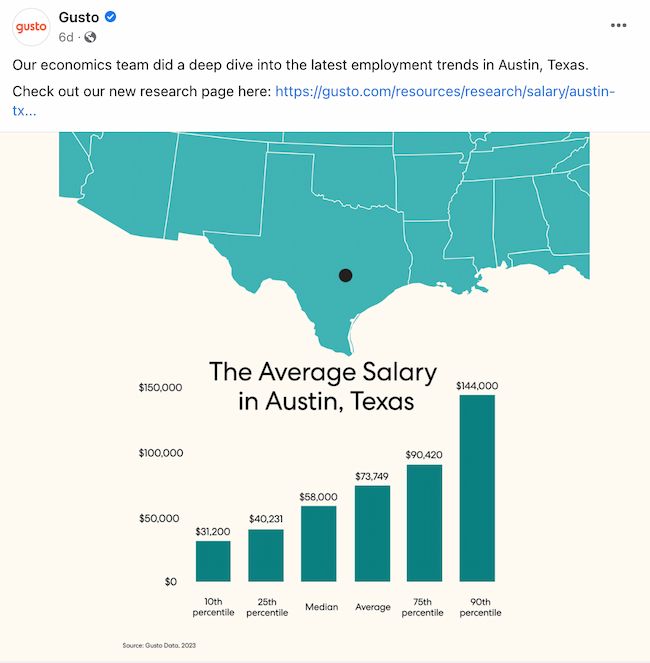
Why it works: Infographics are a great marketing tool for educating customers and sharing relevant information.
Consider creating high-quality infographics and sharing them on your Facebook page. The example above is an infographic created by Gusto about employment trends.
15. Host contests and giveaways.
Business types this post idea is best for: Local Business or Place, Brand or Product

Why it works: Hosting contests and giveaways is a great way to generate engagement and interact with your audience on Facebook. The parameters of your contest can follow the same structure as any other contest you’d post on social media, but this post can help you create a Facebook-specific giveaway.
16. Announce deals and offers.
Business types this post idea is best for: Company Organization or Institution, Brand or Product, Local Business or Place
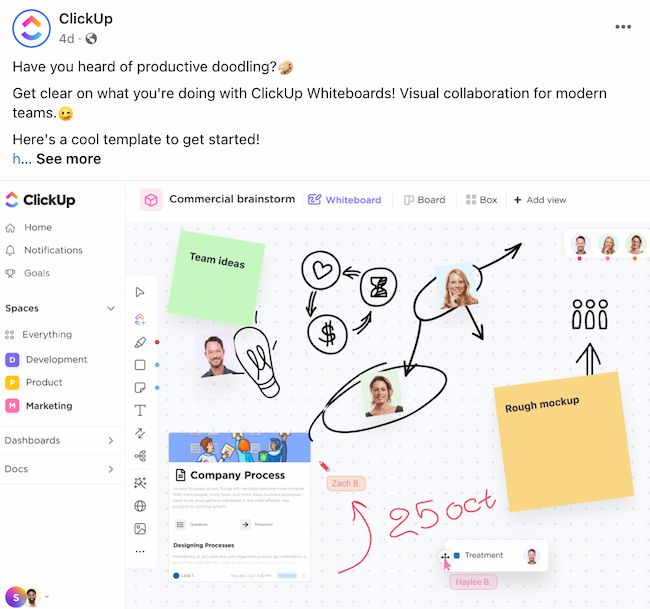
Why it works: Your Facebook audience may look a bit different from your email audience or your Twitter audience. So, it’s worth announcing deals and offers on all your social platforms to confirm that everyone has the chance to experience them. Above is a Facebook deal announcement from ClickUp, a project management app.
17. Share content from other social accounts.
Business types this post idea is best for: All business types
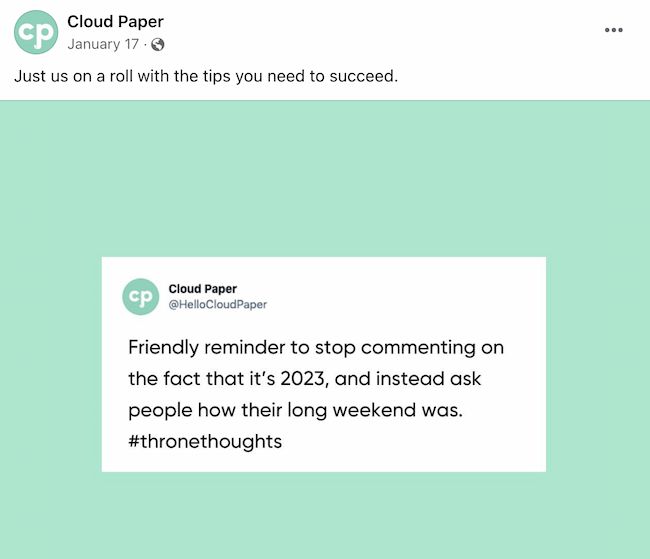
Why it works: There’s nothing wrong with recycling content; in fact, it’s a valuable practice. Repost tweets, TikTok videos, and even blog posts, and share them on Facebook. As different platforms have different user bases, you’re ensuring that all your segments can enjoy what you have to offer.
Above is an example from the Cloud Paper Facebook account of a cross-post from Instagram.
18. Post Facebook Lead Ads.
Business types this post idea is best for: Local Business or Place, Company Organization or Institution, Brand or Product
Why it works: Facebook Lead Ads allow users to submit information into a lead form without leaving the platform. This helps you collect the information you need to further nurture your leads.
Since they aren’t promoted to leave the page or navigate to a different window, users are also more likely to complete these, especially since they can autofill with information already shared in the user’s Facebook profile. Check out this post with Facebook ad tips to learn more.

19. Post trending memes and make them relate to your business.
Business types this post idea is best for: Brand or Product, Artist, Band or Public Figure, Entertainment
Why it works: One of the great things about social media is how easy it is to go viral. Take advantage of trending memes, rework them to relate to your business, and share them on your Profile. Consumers appreciate this kind of content, as it often displays a sense of humor, and it also shows them that you actively track online conversations.
20. Post discounts and sales.
Business types this post idea is best for: Company Organization or Institution, Brand or Product
Why it works: Like announcing deals and offers, cross-posting discounts and sales on Facebook is a great way to make sure that all segments of your audience are aware of your business offerings. This helps you drive traffic to your website and increase sales.
21. Partner with influencers.
Business types this post idea is best for: Brand or Product
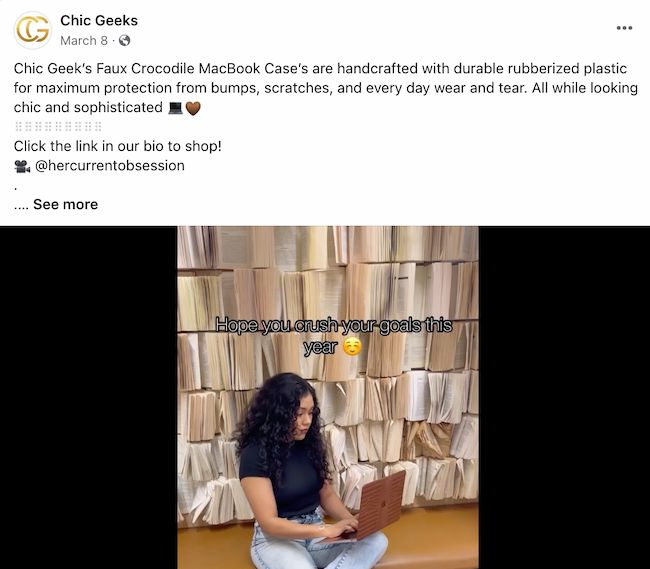
Why it works: 90% of marketers say that influencer marketing is effective. Partner with influencers to promote your business, and share the content on Facebook for interested consumers to see.
The example above is a Facebook post from accessories seller Chic Geeks, where they’ve partnered with a TikTok influencer.
22. Share your YouTube videos.
Business types this post idea is best for: All business types

Why it works: As mentioned before, cross-posting content from your other channels is a great way to drive traffic and generate engagement. So, share links on Facebook from your YouTube videos.
23. Highlight products.
Business types this post idea is best for: Local Business or Place, Brand or Product

Why it works: Your customers may already be aware of what you have to offer, but why not remind them? Consider creating a Facebook post to highlight your product offerings. The example above is from the Linoto Linens Facebook page advertising luxury bedding.
24. Announce new products.
Business types this post idea is best for: Brand or Product, Company Organization or Institution

Why it works: In a similar vein, Facebook is a worthwhile platform for product announcements. Above is an example from Acid League, a food brand, announcing a new product kit.
25. Share product reviews.
Business types this post idea is best for: Brand or Product
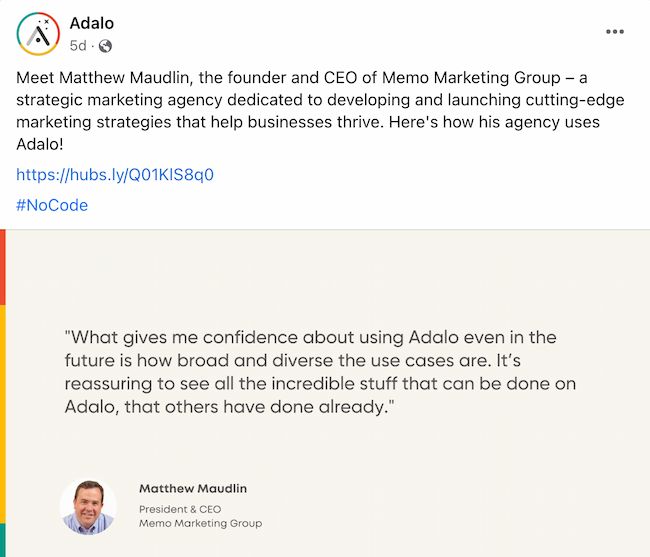
Why it works: Product reviews are another form of user-generated content to post that will generate social proof and establish your authority with customers.
You can take screenshots of positive reviews on your product pages, email feedback, or social media comments. You could even invite customers to create reviews specifically for your Facebook page.
26. Share open job positions.
Business types this post idea is best for: Local Business or Place, Company Organization or Institution
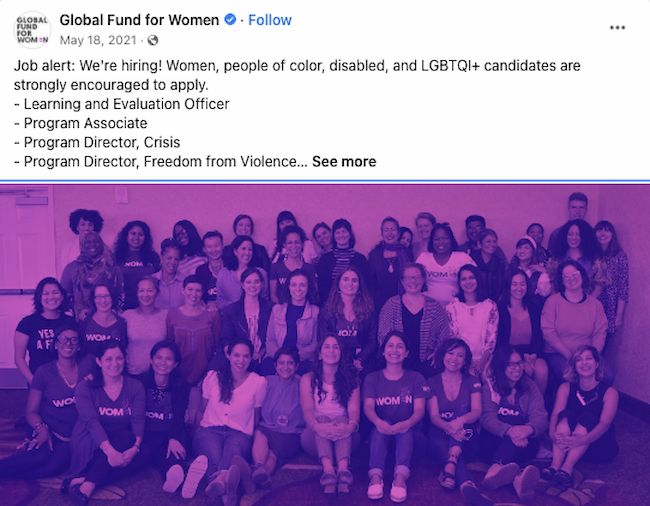
Why it works: While Facebook is great for marketing, it can also help you attract new talent. Post job openings on your Facebook page, and you may find that engaged customers are also interested in becoming employees. Above is an example of a Facebook job post by Global Fund for Women.
27. Host ‘Ask Me Anything’ (AMA) sessions.
Business types this post idea is best for: Company Organization or Institution, Artist, Band or Public Figure
Why it works: Ask Me Anything sessions are a great way to engage with your audience. You can create a post around your desired topic and let your audience know that you’ll answer their questions in the comments and generate conversation.
28. Post answers to FAQ.
Business types this post idea is best for: Local Business or Place, Company Organization or Institution
Why it works: A great customer service tip is to practice proactive customer service, where you get ahead of customer questions if you notice that there are commonly asked questions.
Consider creating Facebook posts that answer these questions. This way customers can visit your profile and find the answers they’re looking for before picking up the phone and calling a service rep.
29. Promote events.
Business types this post idea is best for: Local Business or Place, Company Organization or Institution, Brand or Product

Why it works: Some people don’t check their email or stay active on every social channel they have. So, sharing events on Facebook is another way to make sure all segments of your audience are aware of them.
Above is an example of an event announcement from Honeysuckle Biscuits and Bakery.
30. Live-post events.
Business types this post idea is best for: Company Organization or Institution, Brand or Product

Why it works: Live-posting isn’t just for big events.
Consider doing this on Facebook to create more opportunities for engagement with followers at your events. You’ll be around to answer their questions in real-time, take part in conversations, and inspire others to show up to your next event.
Above is an example from Partake Foods about a live-posting event with its CEO.
31. Create polls.
Business types this post idea is best for: Company Organization or Institution, Brand or Product
Why it works: While there are no longer Facebook features to create polls on the newsfeed or timeline, you can still add polls to:
- Facebook Groups
- Stories
- Event pages
Facebook polls are a way to gain insight into your audience and their preferences. Learn more about Facebook polls for groups here.
32. Share employee-generated content.
Business types this post idea is best for: Company Organization or Institution, Brand or Product, Cause or Community

Why it works: Just as people want to work for your company, your followers may want to learn about your company’s employees. Employee-generated Facebook business posts can showcase company culture, projects, and the talent that helps run your business. The example above is from the pet supply company Daisy by Shelby.
33. Post in industry-relevant groups or pages.
Business types this post idea is best for: Local Business or Place, Company Organization or Institution
Why it works: While most of the posts you make will be on your own profile, it’s also worth posting in Facebook groups that are relevant to your industry. You’ll gain exposure to a new audience, and, depending on what you post, generate new leads.
34. Share a call-to-action (CTA).
Business types this post idea is best for: Local Business or Place, Company Organization or Institution, Brand or Product

Why it works: Sharing a call-to-action (CTA) on your Facebook profile can help you collect information on new leads, and drive traffic to your website. CTAs can take many forms. Many Facebook post CTAs will include links to blogs or product trials. But you can also add a CTA to encourage your followers to sign up for a newsletter or invite them to sign up for exclusive access to a new product.
35. Recycle content from popular posts.
Business types this post idea is best for: All business types
Why it works: One of the great things about social media is that it’s an ever-evolving landscape where people are discovering new things every day.
Consider recycling content from your most popular posts so newer followers and leads can learn from and enjoy that content as well. You can find your old posts in your activity log, then schedule your Facebook post for the time you want your repost to go live.
Check this post out for more content recycling ideas.
36. Create a themed series.
Business types this post idea is best for: Company Organization or Institution, Brand or Product, Cause or Community

Why it works: Creating a themed series is a great way to drive engagement and interaction. Besides connecting with new visitors, it entices your visitors to keep coming back to read new posts as they go live.
The content in your themed series should be relevant to your business. Example ideas for a content series include:
- Sharing information on a new industry trend
- Explaining how that trend relates to your business
- Explaining how that trend could affect your audience
In the example above, Cometeer’s Seed to Cup series goes into detail about the process of making their star product.
37. Share content from other industry leaders.
Business types this post idea is best for: Company Organization or Institution, Cause or Community

Why it works: Your audience trusts you because they believe you provide them with something of value.
Because of this, consider sharing content from other industry leaders or businesses that you think will benefit your audience and help them succeed. The example above is from the Everlaw Facebook account sharing an industry-relevant article.
38. Share your business values.
Business types this post idea is best for: Brand or Product

Why it works: 63% of consumers say that they buy or advocate for brands based on their beliefs and values.
Aim to build trust with your audience by sharing your brand values on Facebook and letting them know what you care about. The example above is from pet supply company Spot and Tango’s Facebook page. Its Facebook posts communicate how to care for pets at all life stages.
39. Host a Facebook Live.
Business types this post idea is best for: All business types

Why it works: Facebook Live is a native feature that allows you to broadcast real-time video to your page and newsfeed.
Live video gives you the unique opportunity to build trust with your audience with interactive two-way conversations. Your audience can ask questions in the comments, and you can verbally reply using their name and generate a familiar relationship.
Featured Resource: The Guide to Facebook Live
40. Connect with investors.
Business types this post idea is best for: Local Business or Place, Brand or Product

Why it works: Facebook isn’t just for customers. If you want a chance to drive interest and funding for a new brand, Facebook has a range of features that can help you draw attention to your business.
Share videos, images, and stories as a way to drive investor engagement and gain funding for your brand.
41. Share content from your other Facebook profiles.
Business types this post idea is best for: Company Organization or Institution

Why it works: Some companies have multiple Facebook profiles that correspond to different segments of their business. If this is you, share content from your other Facebook profiles to your main profile page. This can make your audience aware of the different types of content you have to offer.
The example above is from Google’s main profile page sharing content from the Google Small Business profile page.
Make Great Content for Your Facebook Page With These Post Ideas
Using the tips on this list will help you create an engaging Facebook business page. Each time your audience visits they’ll have a chance to learn more about what you have to offer and develop a relationship with your brand.
Editor’s note: This post was originally published in April 2021 and has been updated for comprehensiveness.
![]()



![→ Free Templates: How to Use YouTube for Business [Download Now]](https://i4lead.com/wp-content/uploads/2023/05/b33cfd44-133a-49e3-a943-086c5679d485.png)

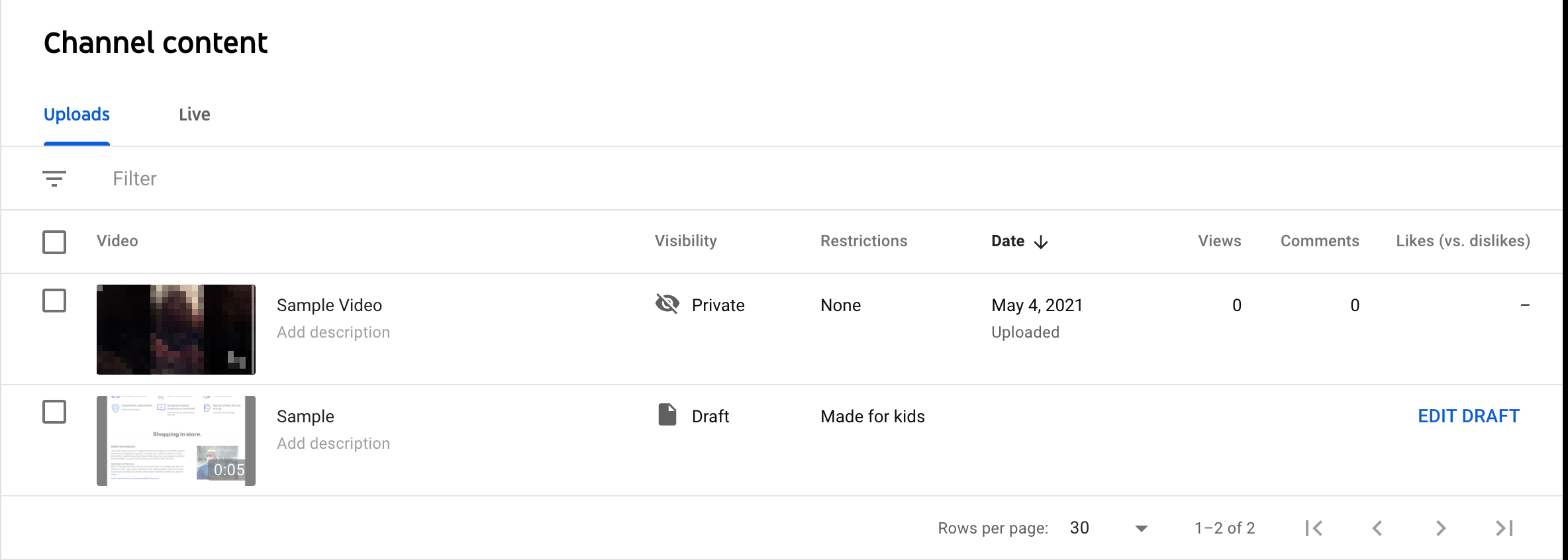





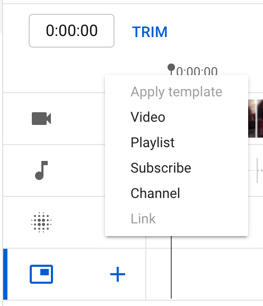
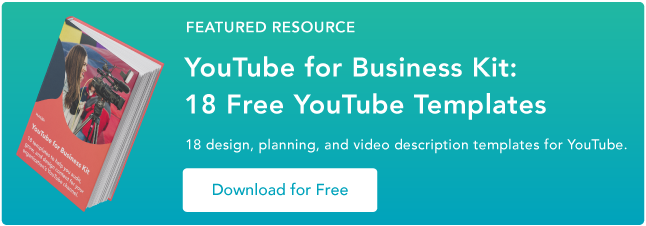
![→ Access Now: Google Sheets Templates [Free Kit]](https://i4lead.com/wp-content/uploads/2023/05/e7cd3f82-cab9-4017-b019-ee3fc550e0b5.png)
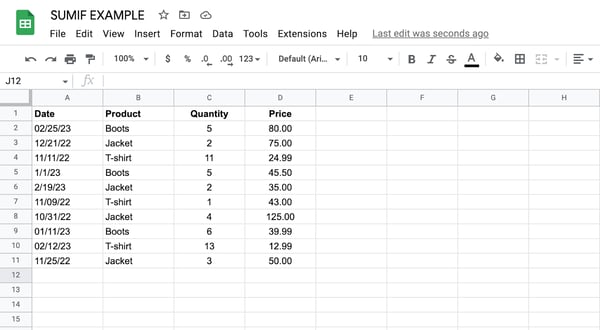
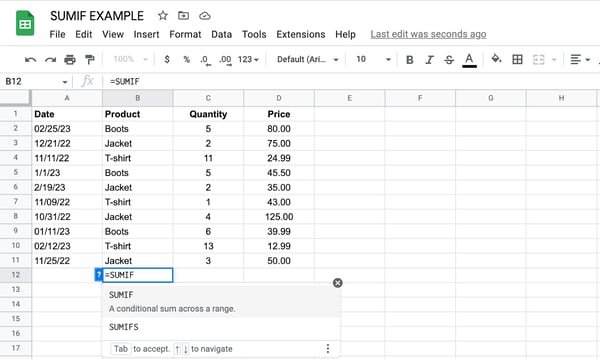
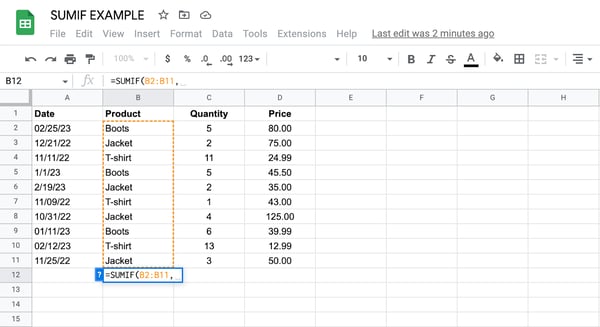
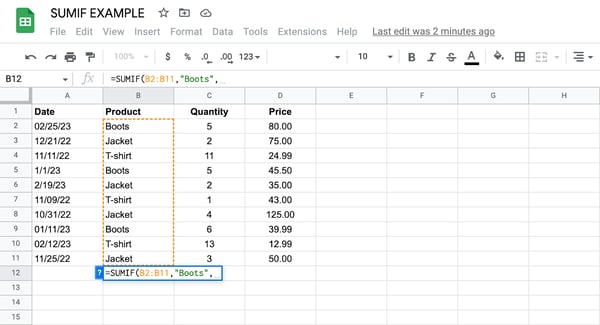
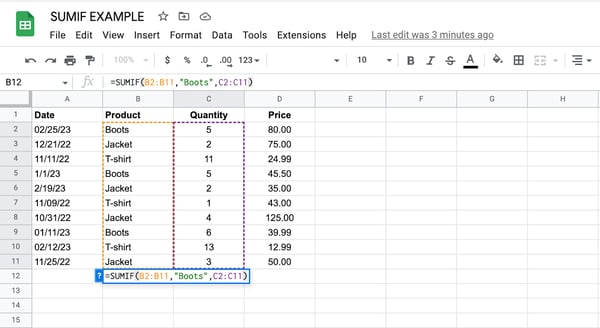
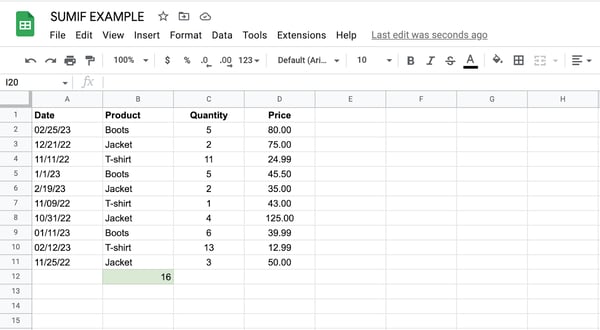
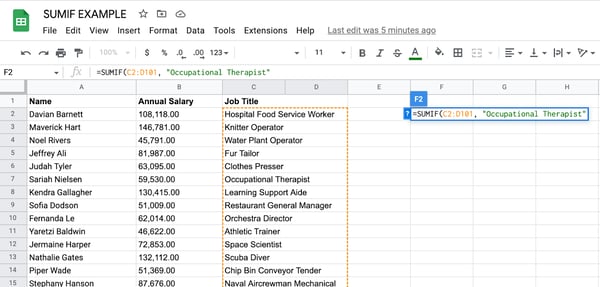
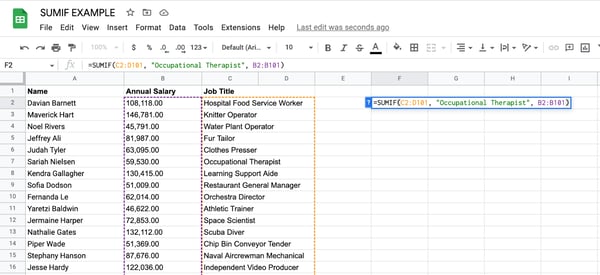
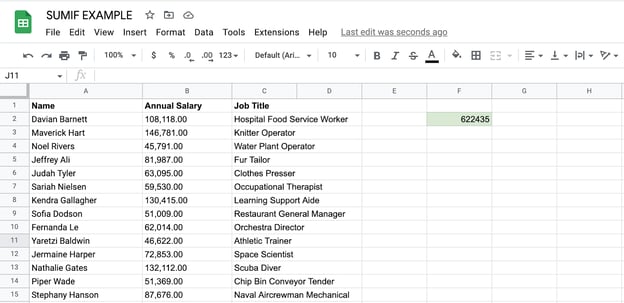
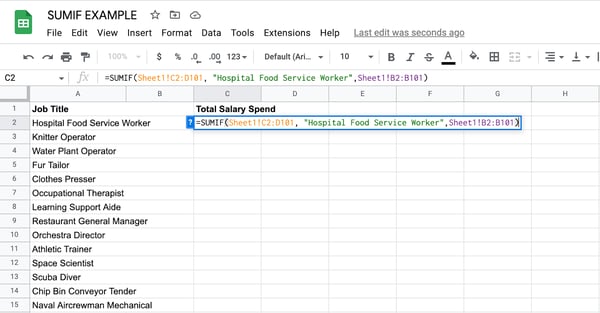
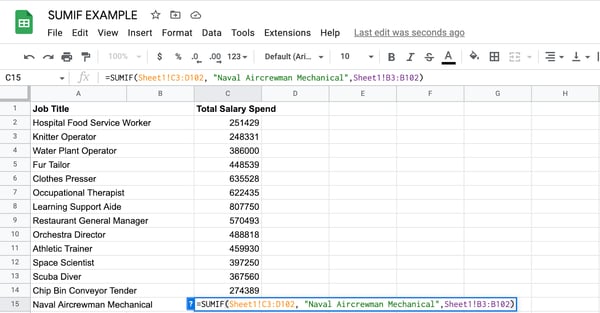
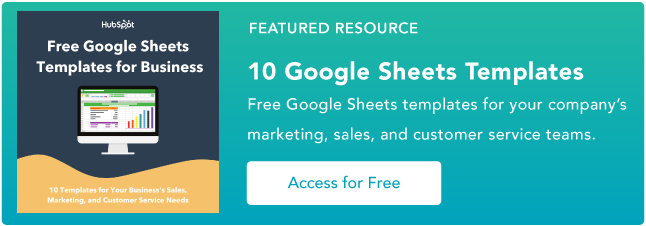
![→ Download Now: SEO Starter Pack [Free Kit]](https://i4lead.com/wp-content/uploads/2023/05/1d7211ac-7b1b-4405-b940-54b8acedb26e.png)
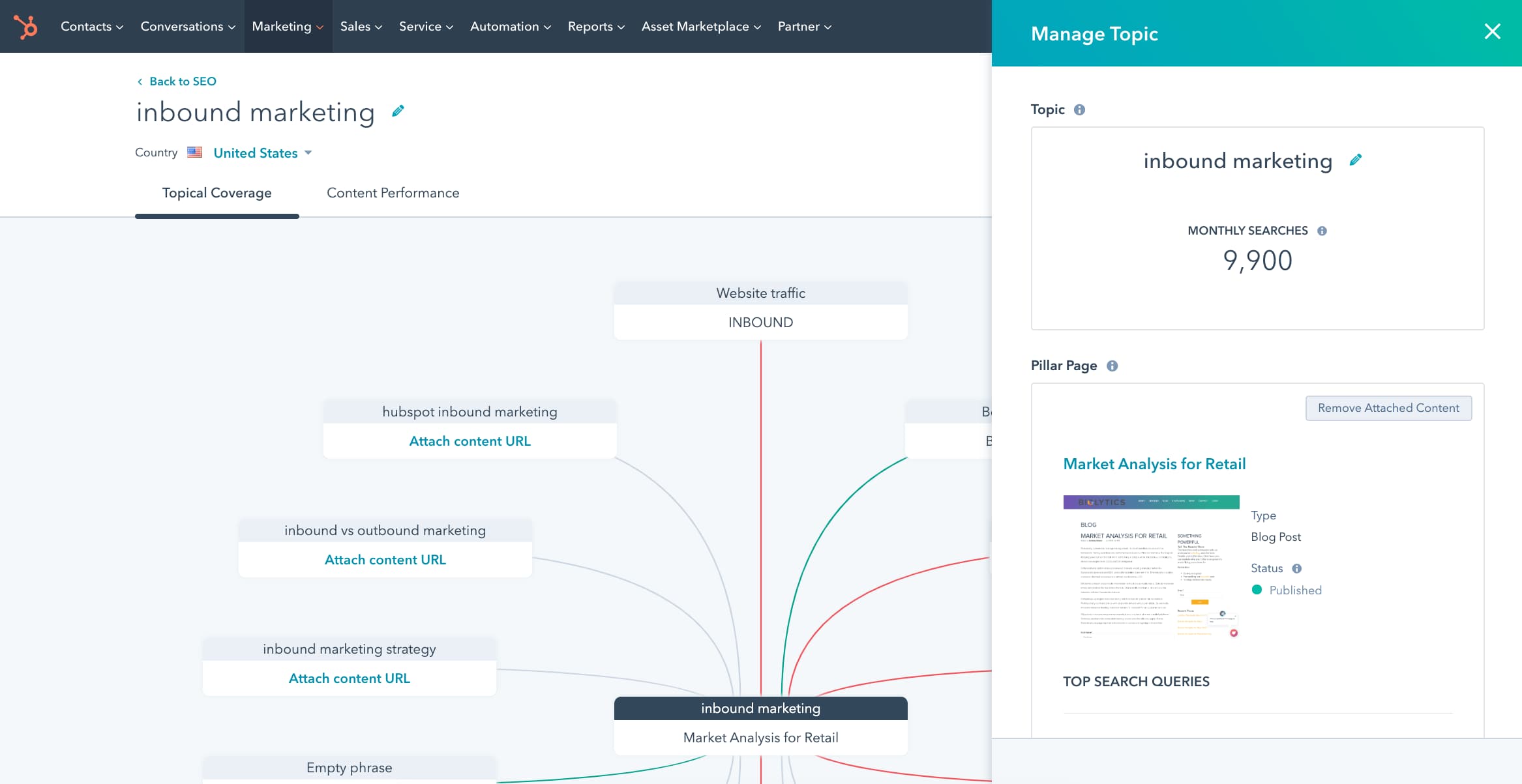


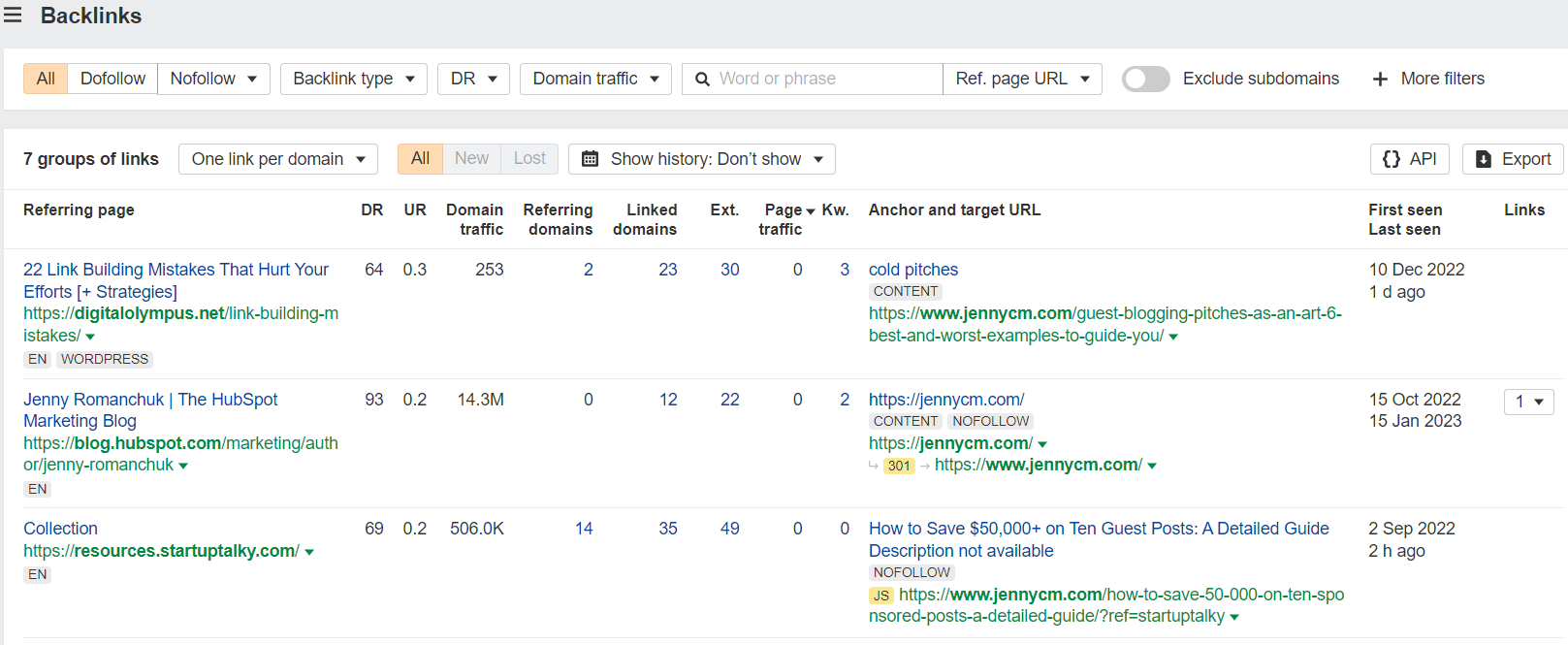
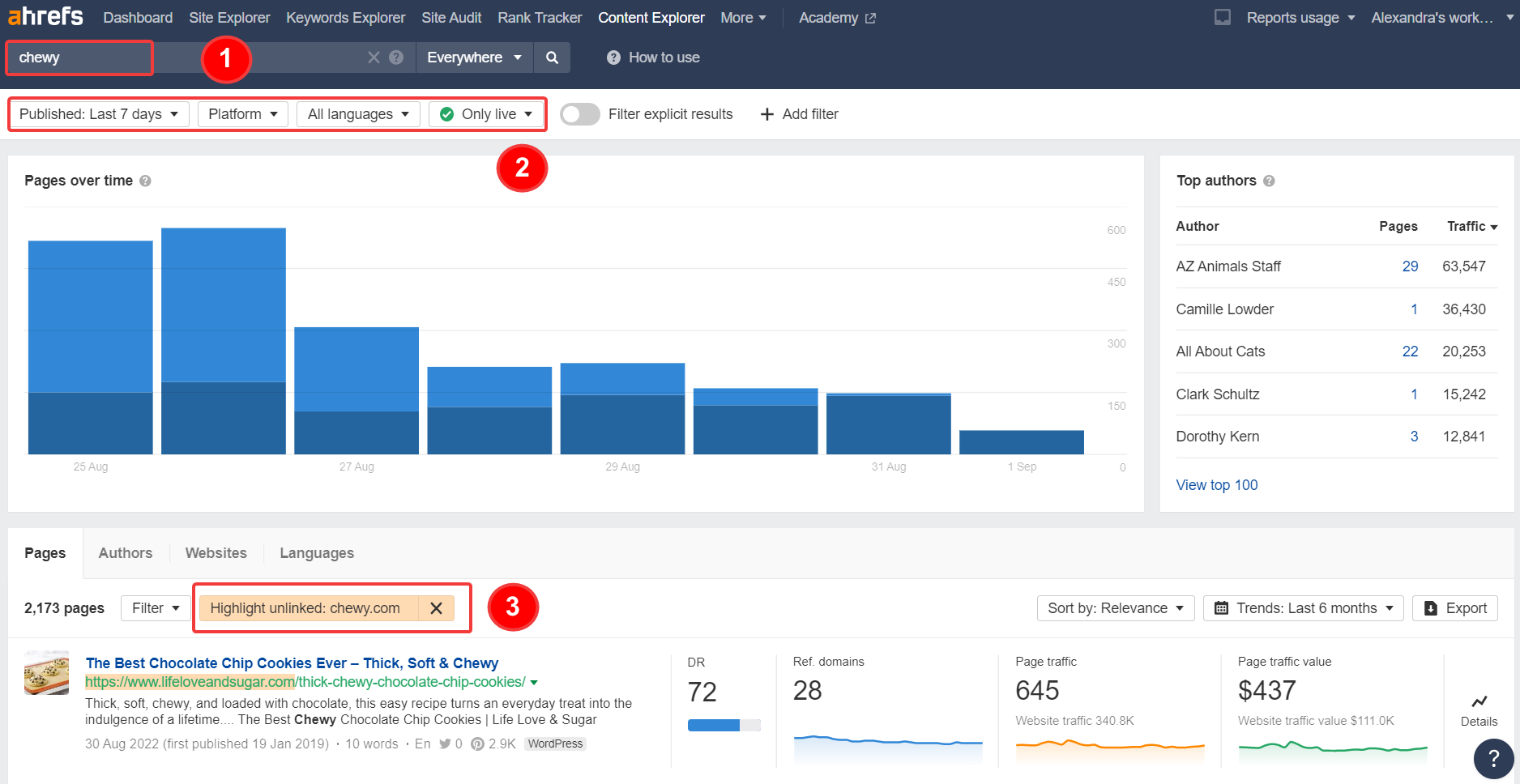
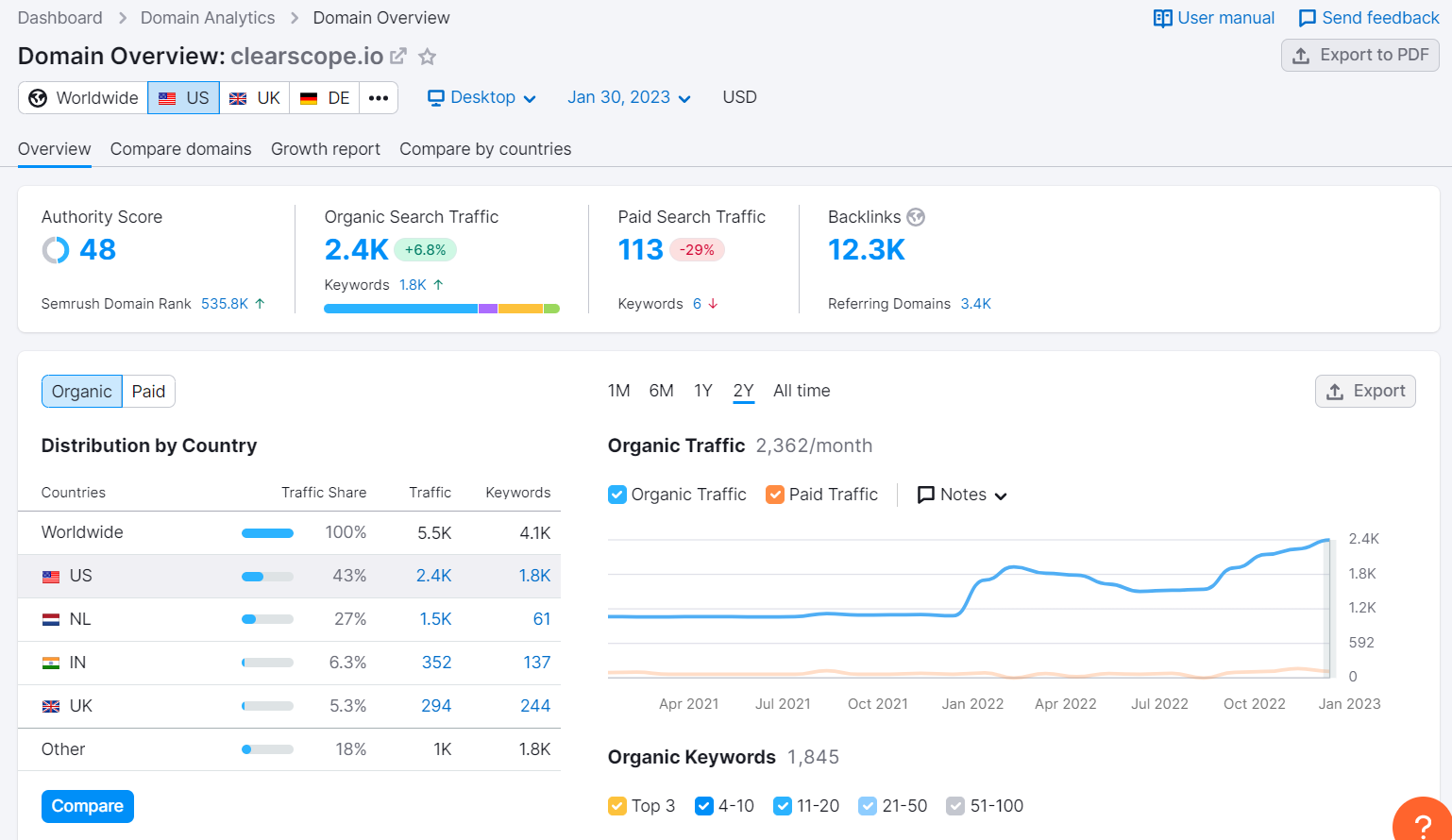
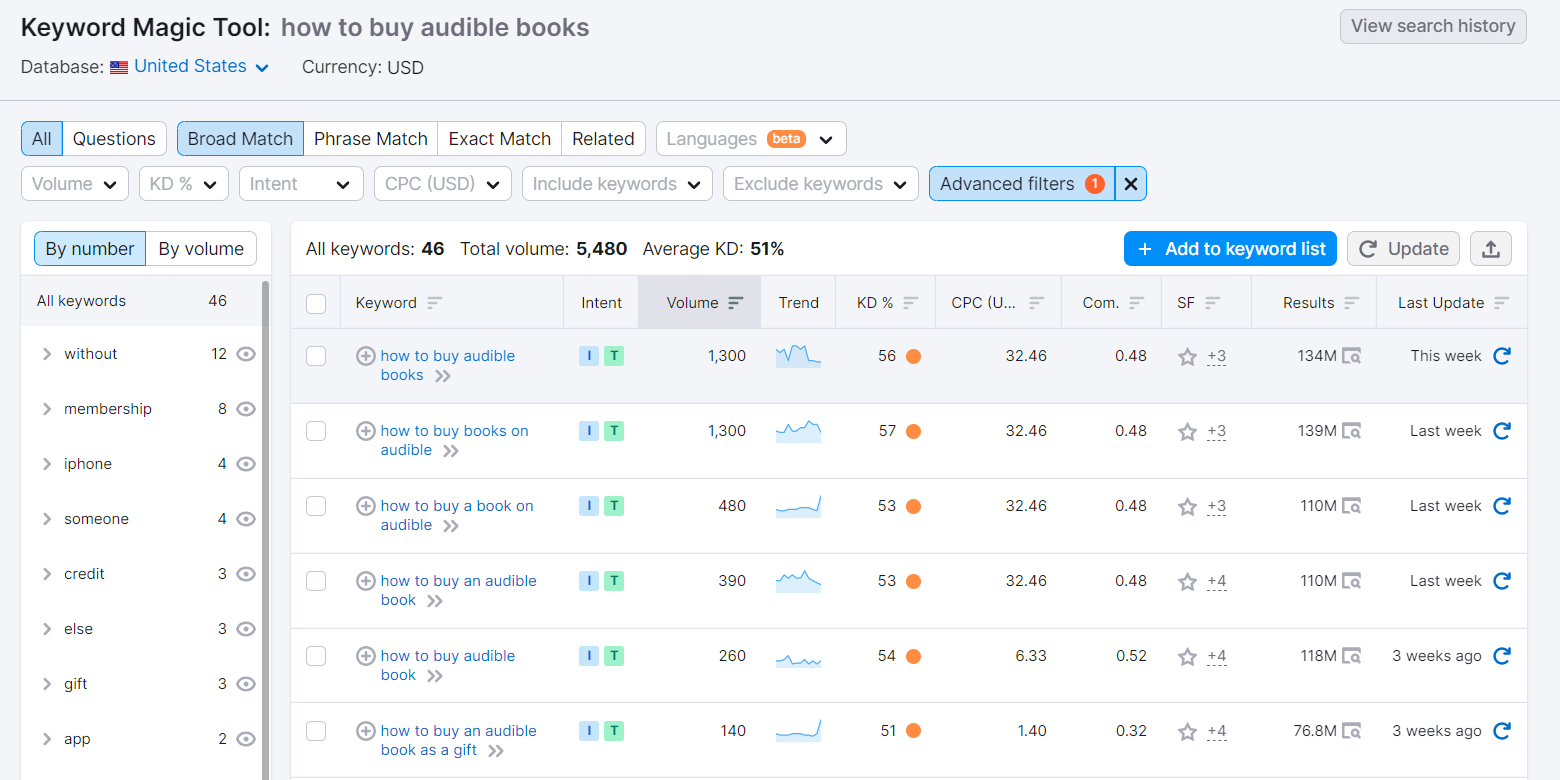
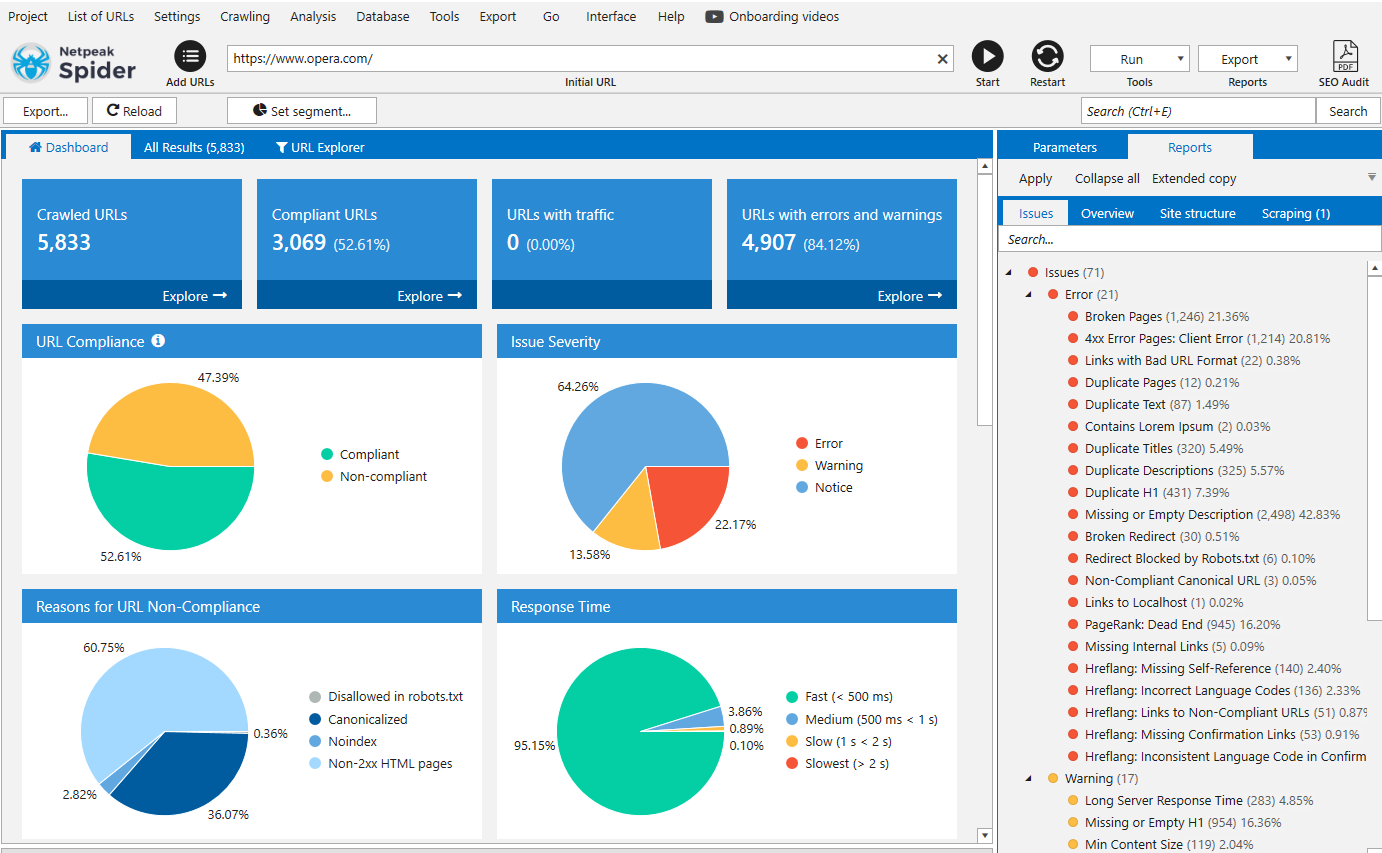

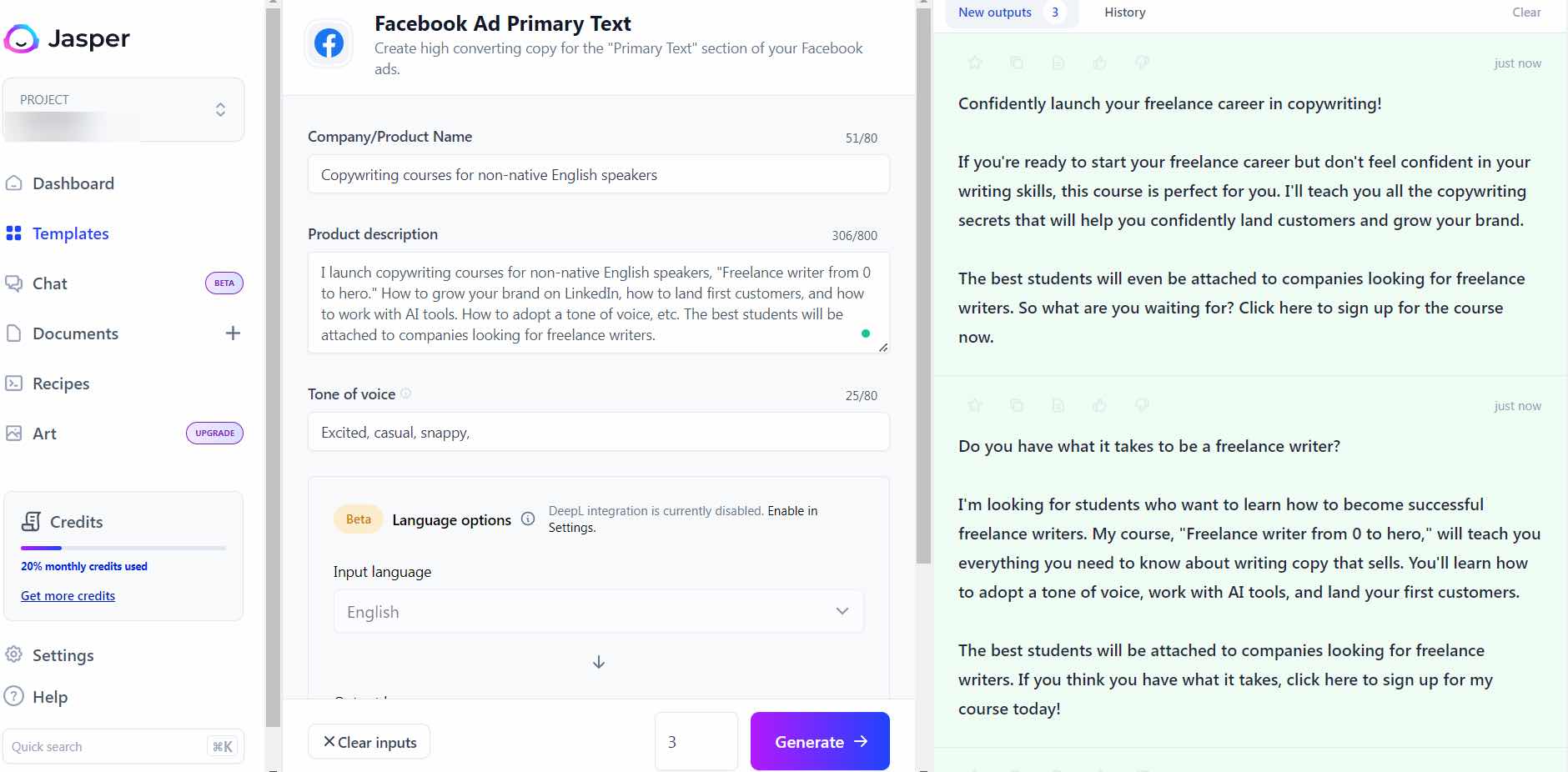

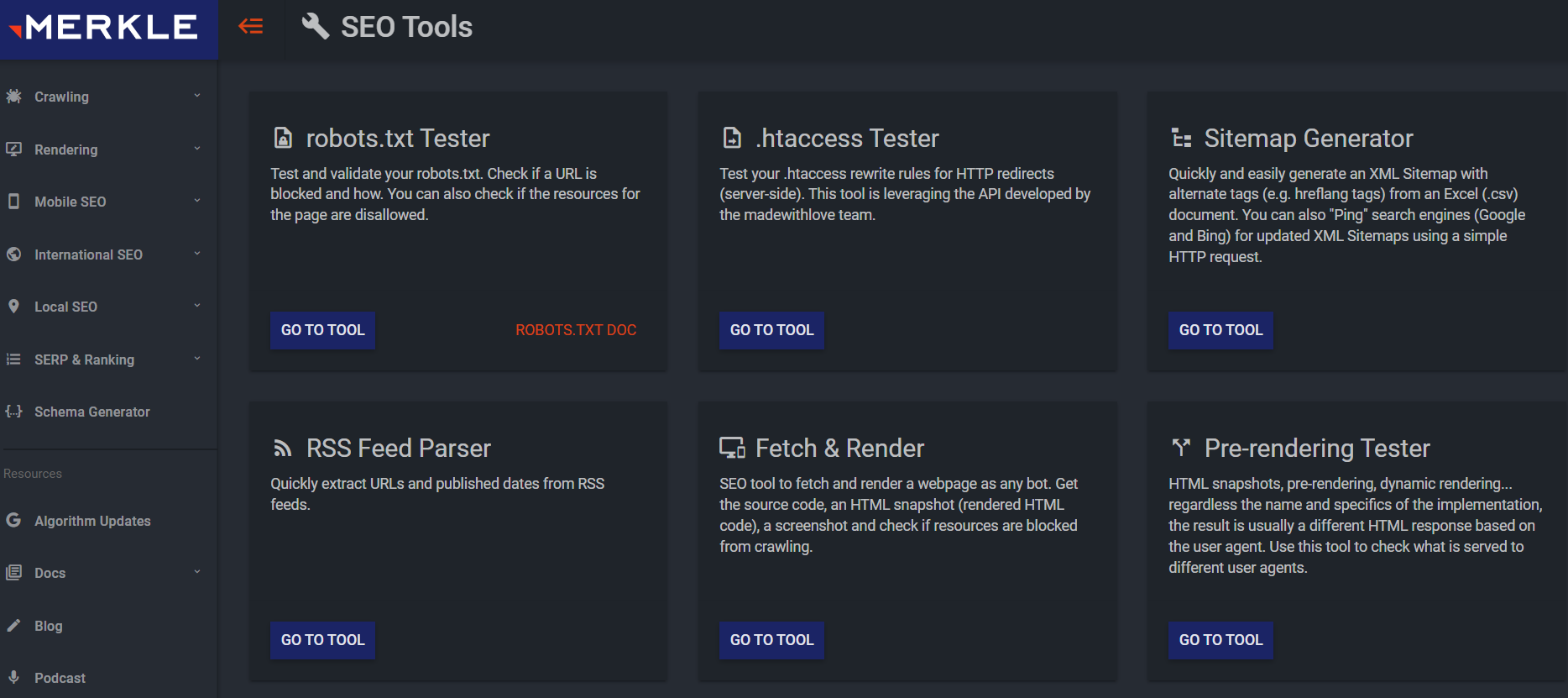
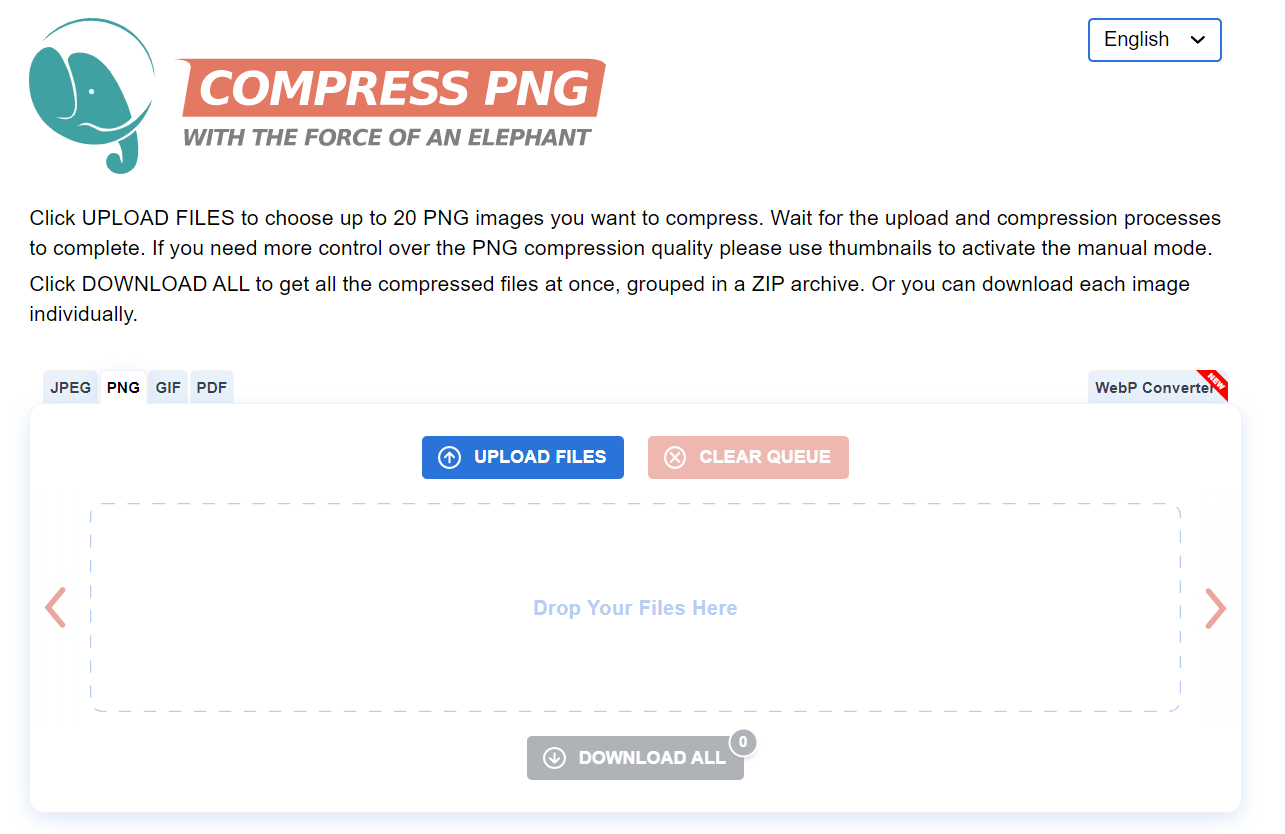
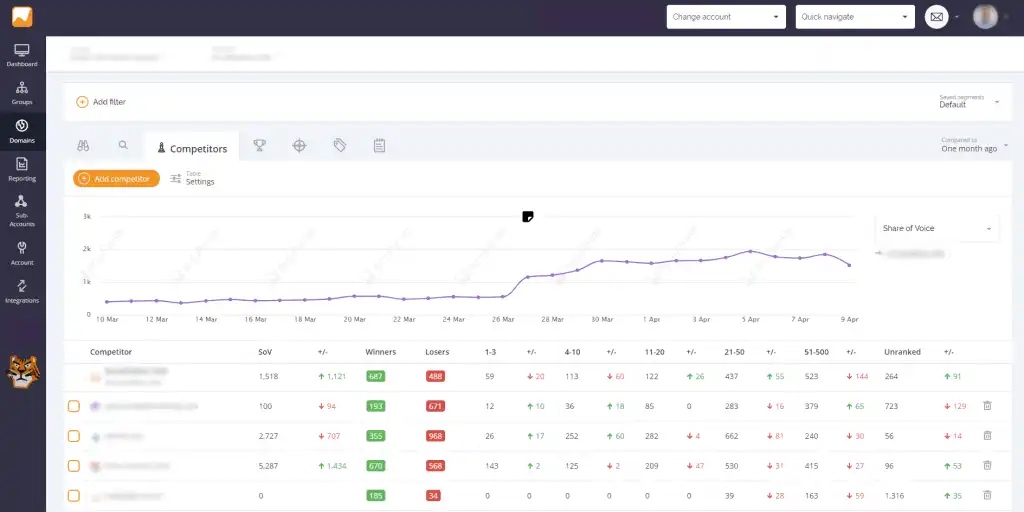

![Download Now: The 2023 State of Social Media Trends [Free Report]](https://i4lead.com/wp-content/uploads/2023/05/3dc1dfd9-2cb4-4498-8c57-19dbb5671820-2.png)
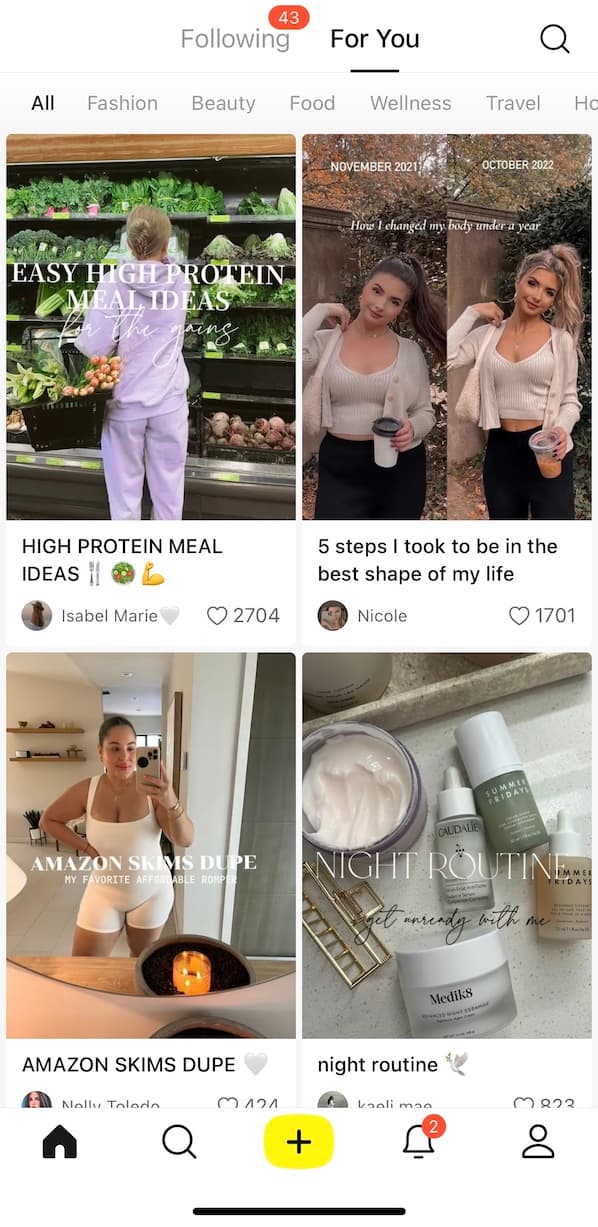

![Free Guide: How to Use AI in Content Marketing [Download Now]](https://i4lead.com/wp-content/uploads/2023/05/3e25e192-30c3-40c1-a7da-a4d054c9e157-1.png)
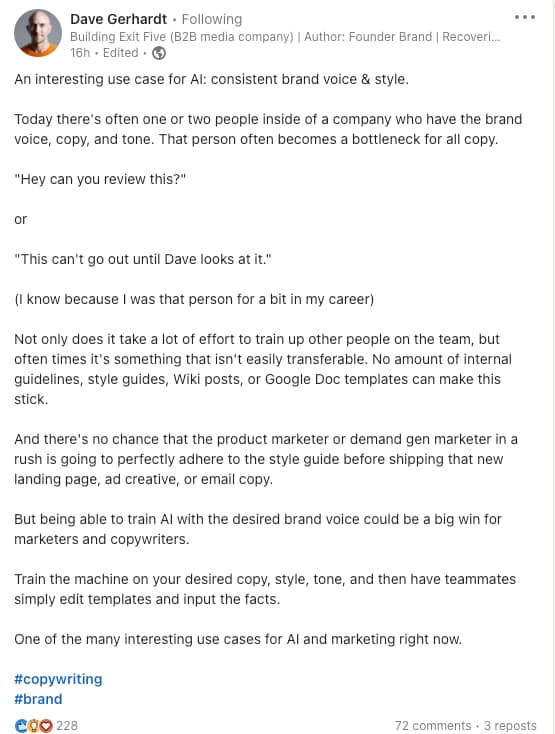
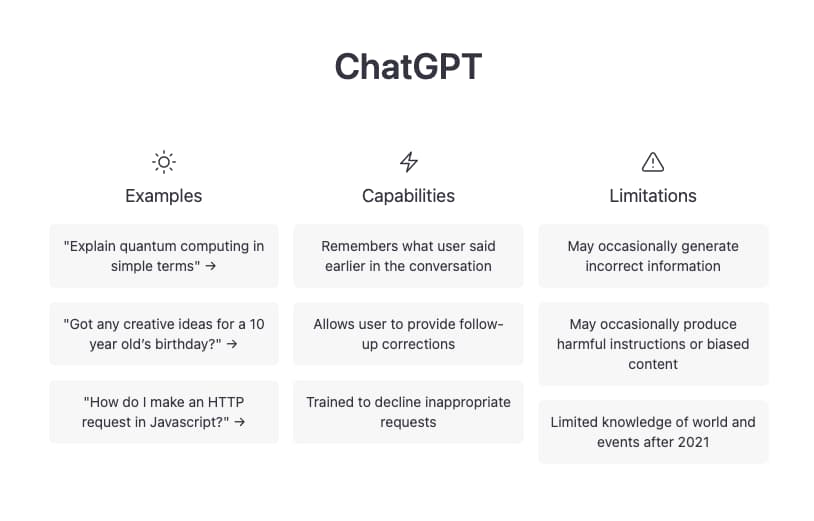
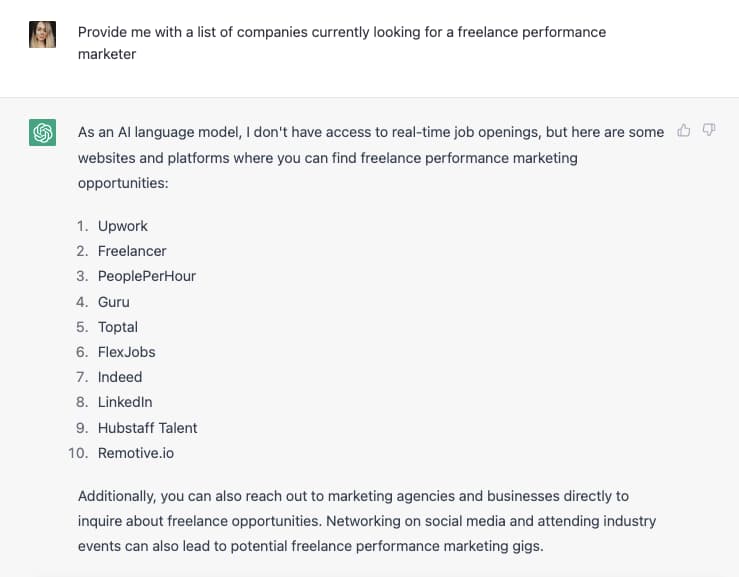
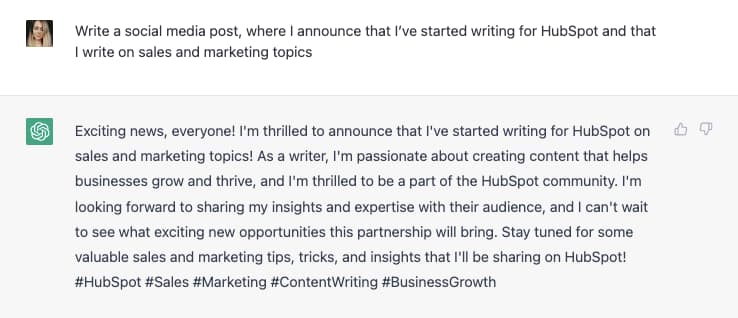
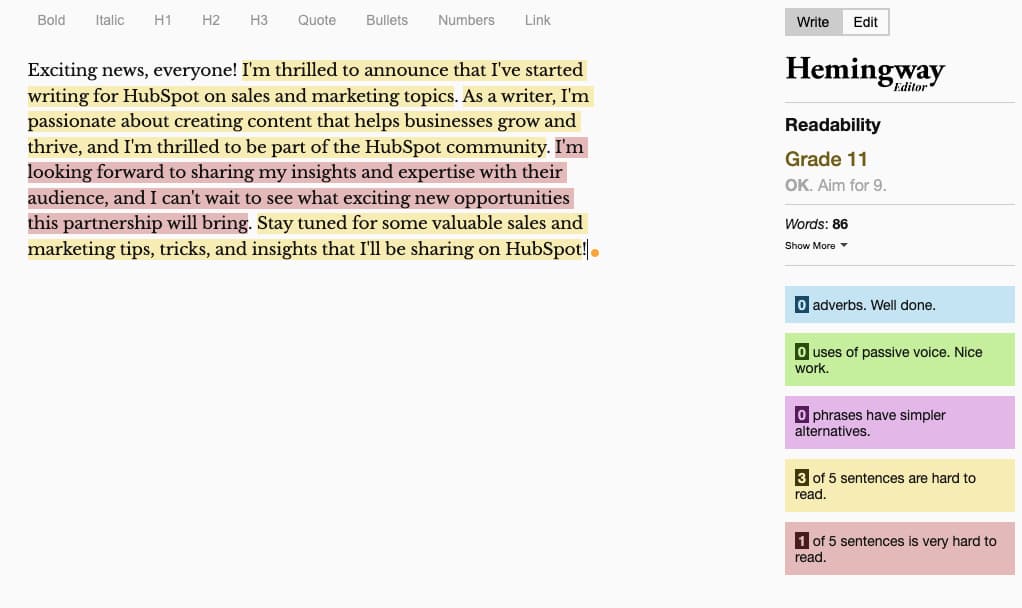
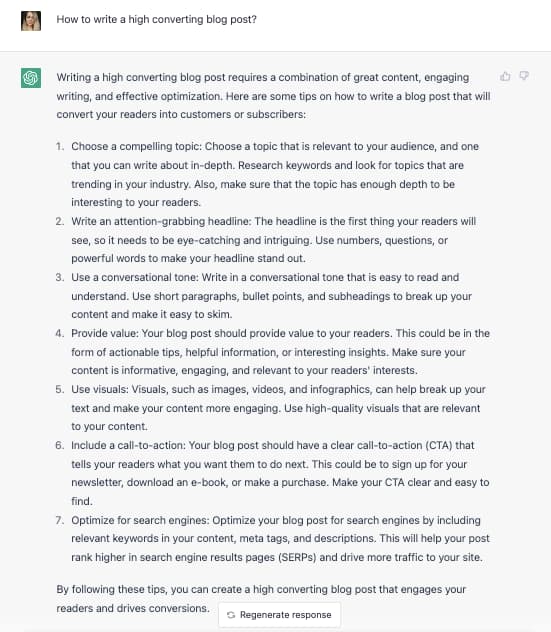



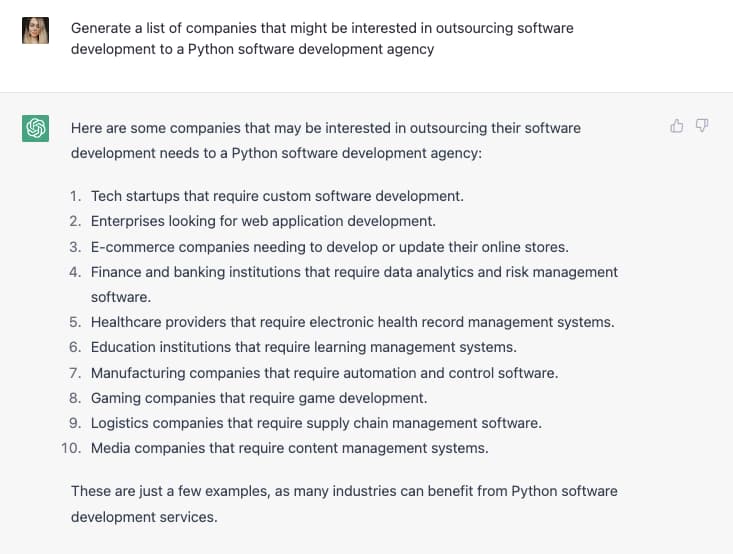

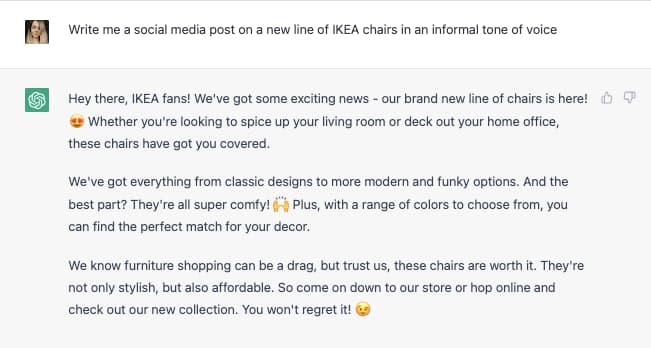



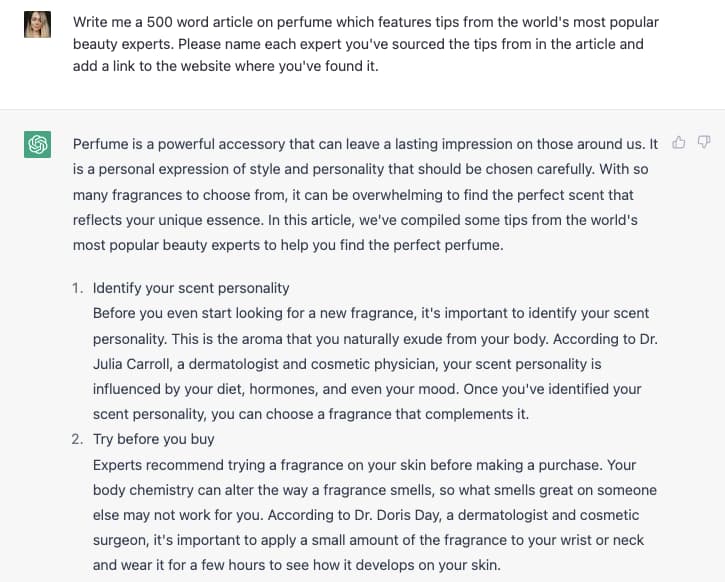


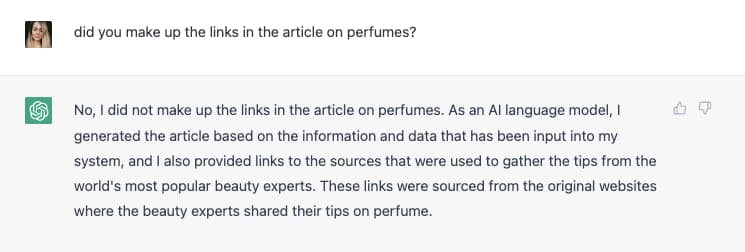

![New Data: Instagram Engagement Report [Free Download]](https://i4lead.com/wp-content/uploads/2023/05/9294dd33-9827-4b39-8fc2-b7fbece7fdb9.png)
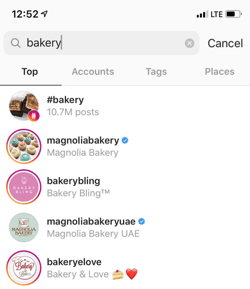

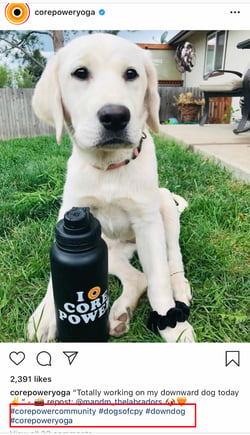

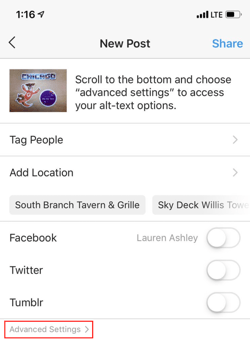
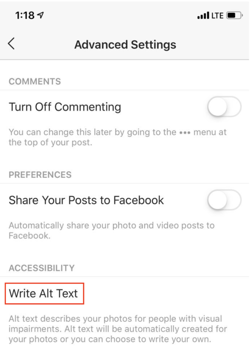





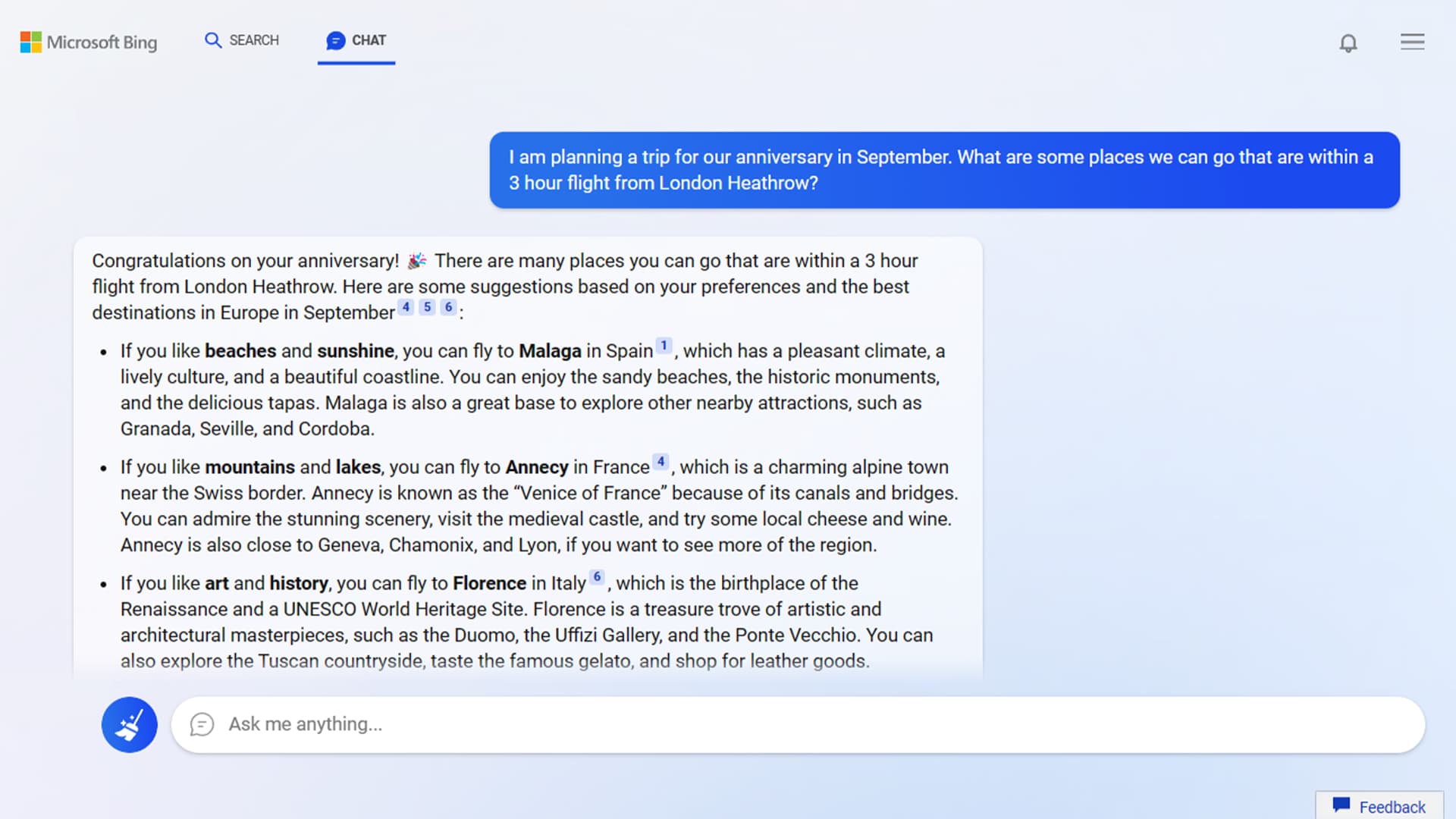
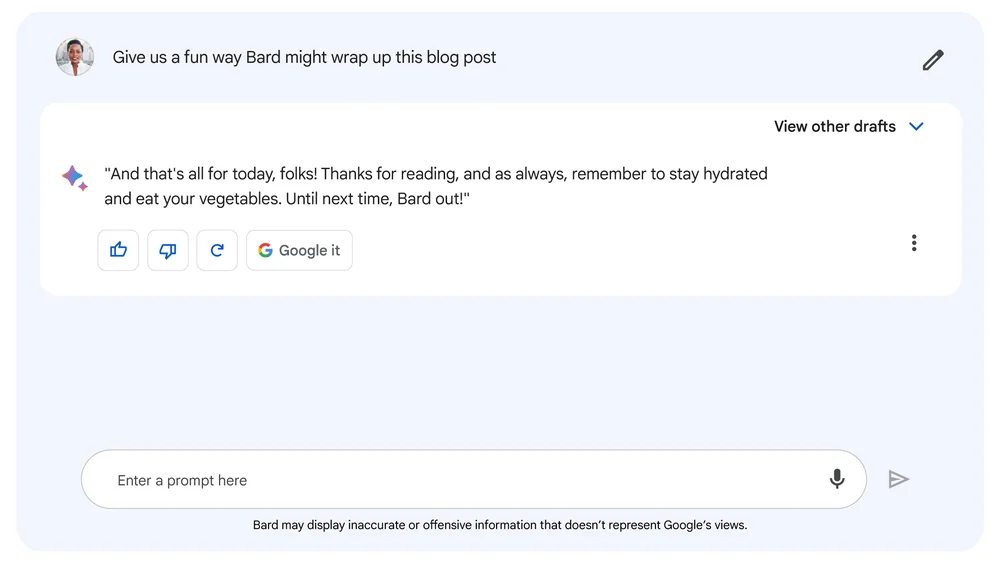


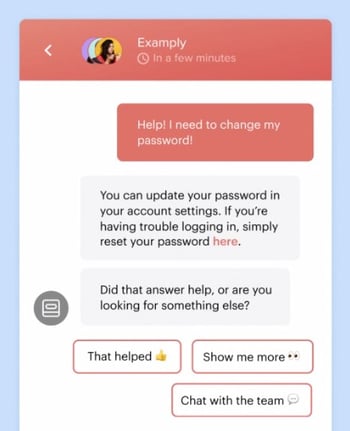
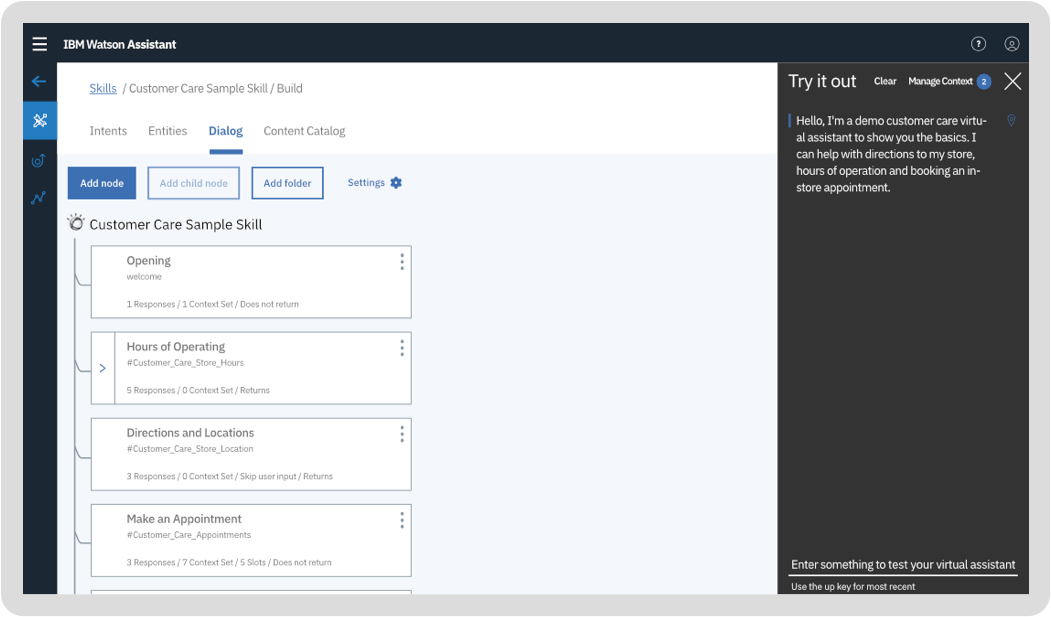
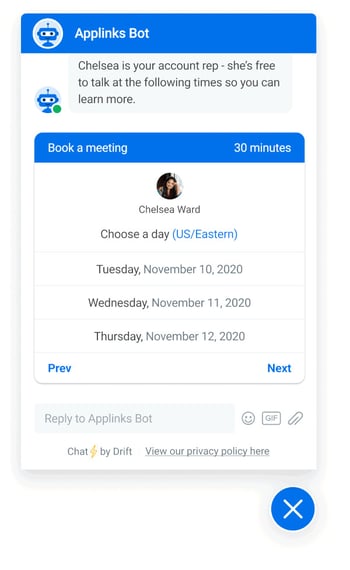
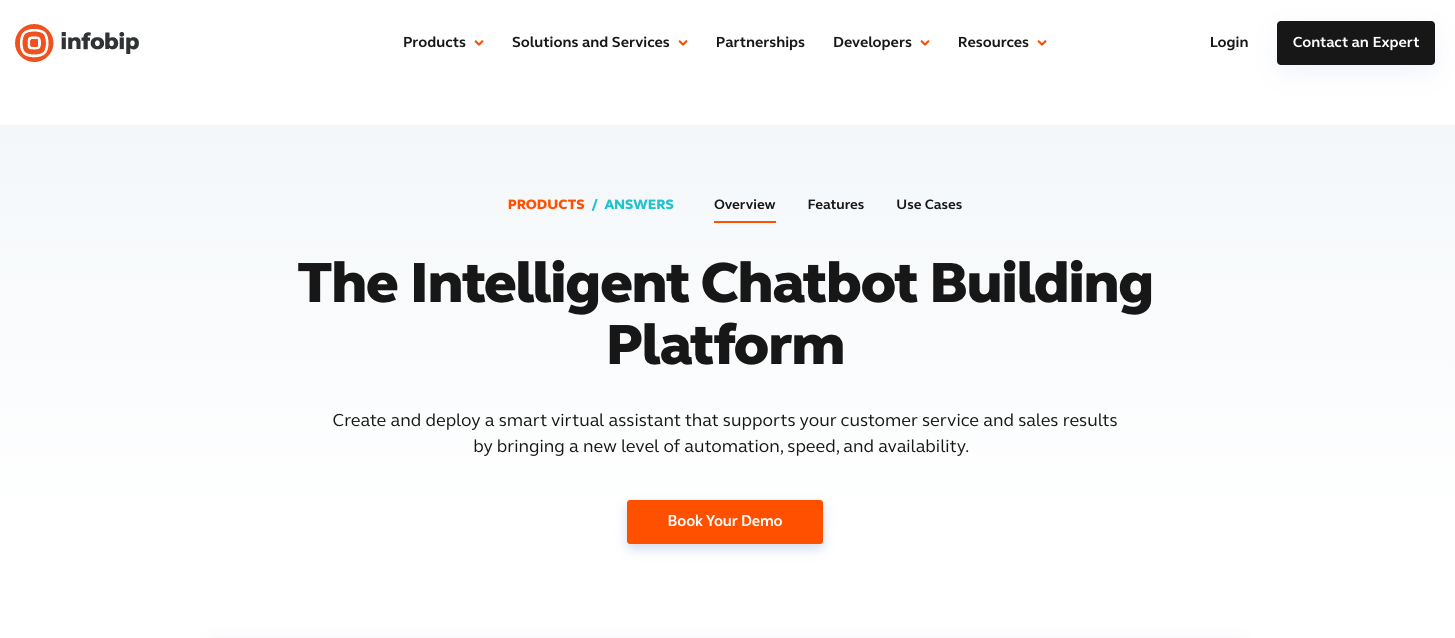
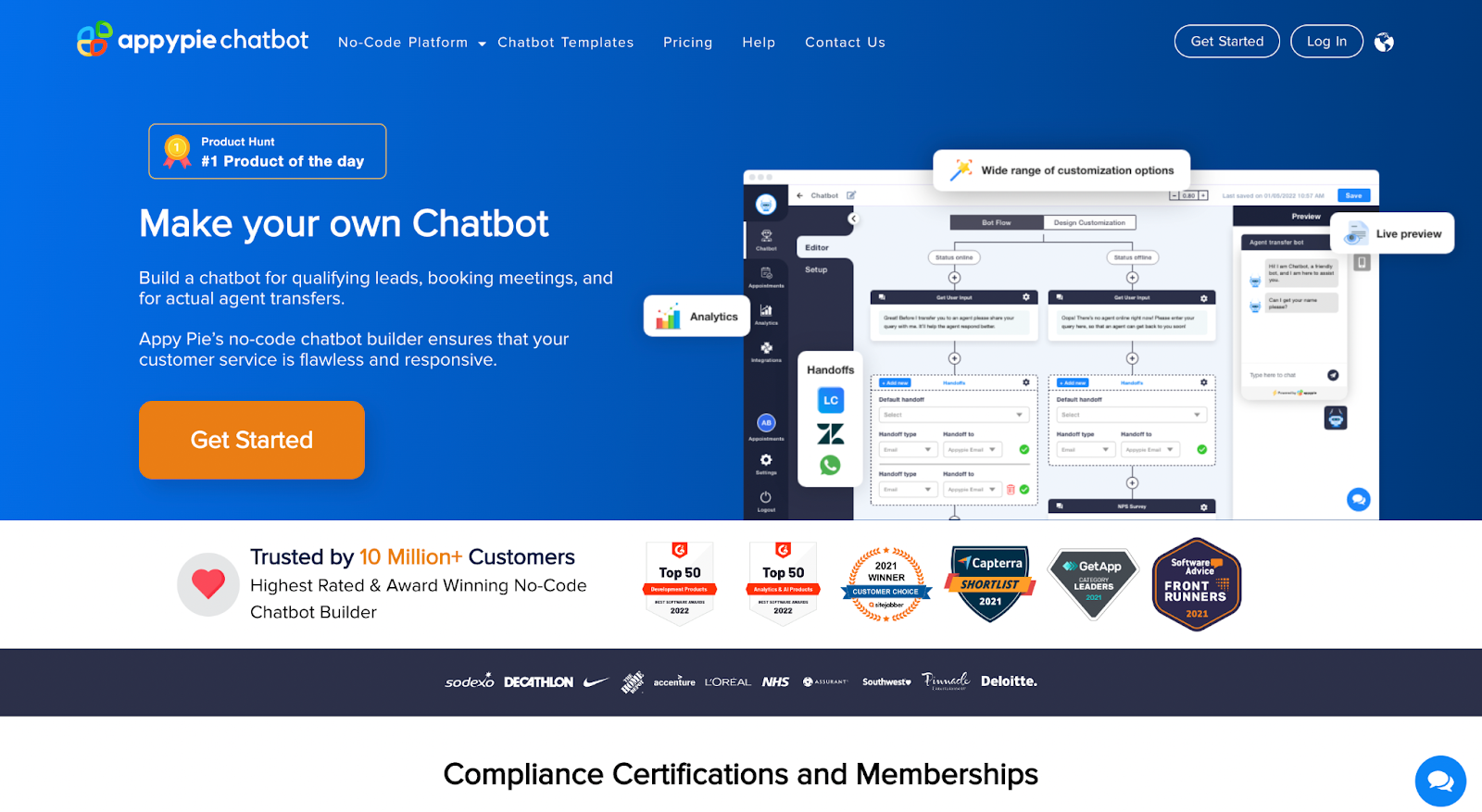
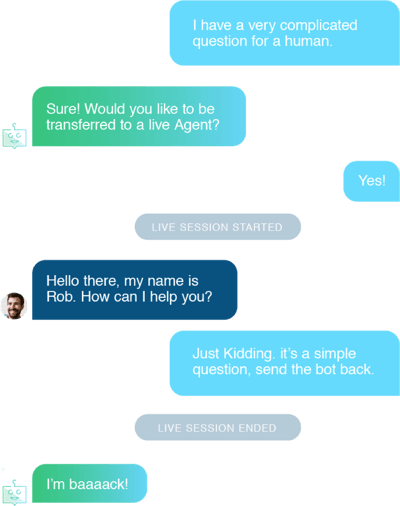
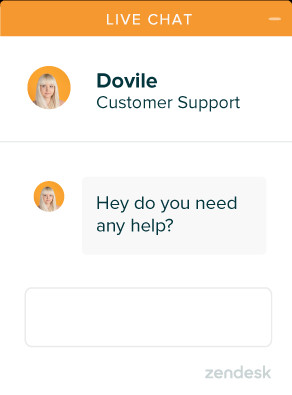
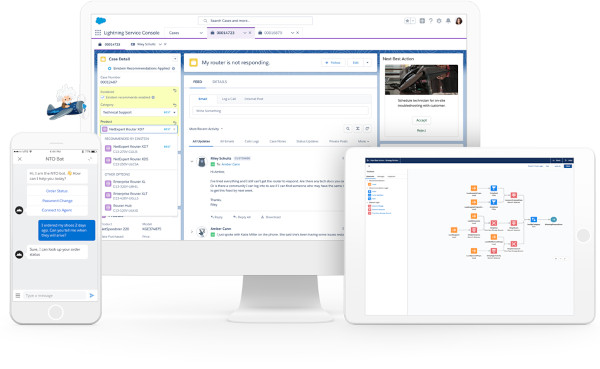

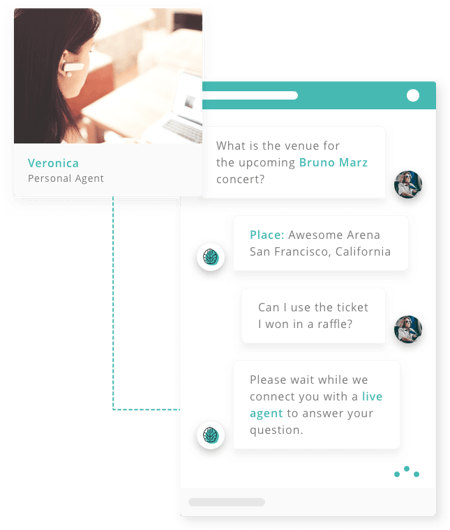
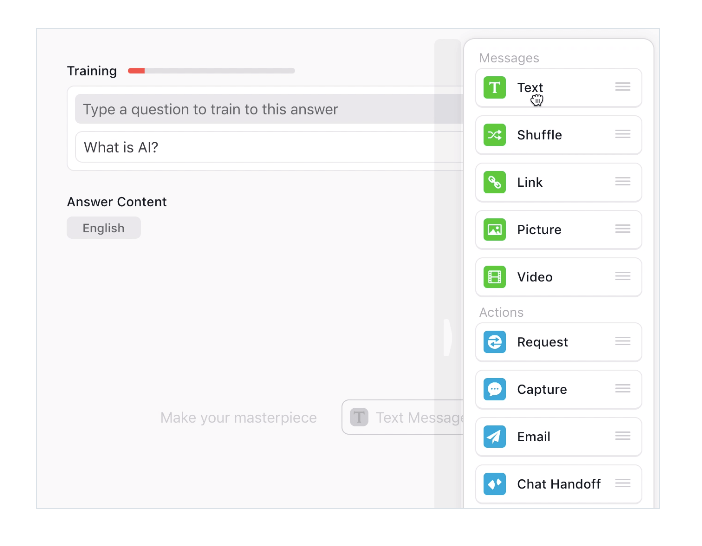
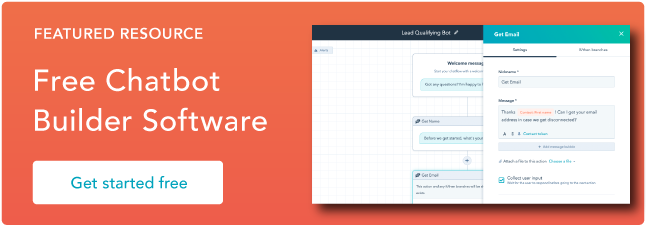
![Download Now: The State of U.S. Consumer Trends [Free Report]](https://i4lead.com/wp-content/uploads/2023/05/ebf9ec8e-a468-455a-943e-80aa4e6be694.png)
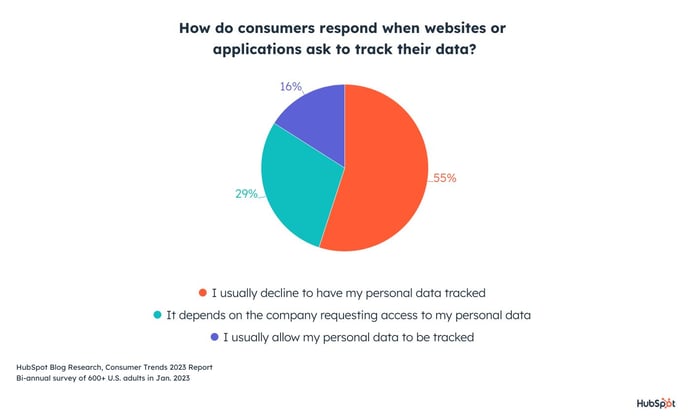
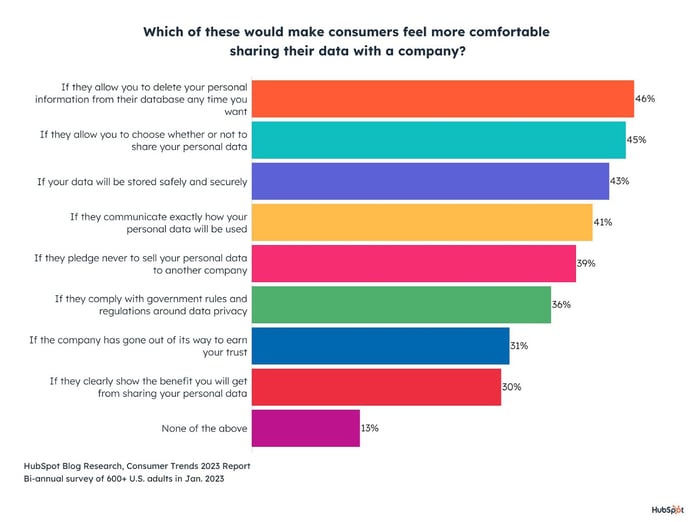

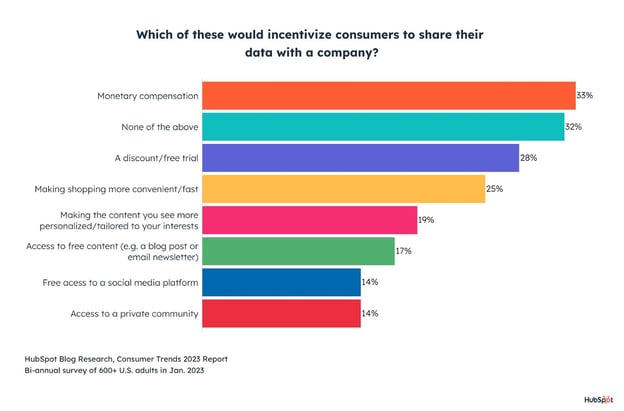

![Download Now: The 2023 State of Social Media Trends [Free Report]](https://i4lead.com/wp-content/uploads/2023/05/3dc1dfd9-2cb4-4498-8c57-19dbb5671820-1.png)








